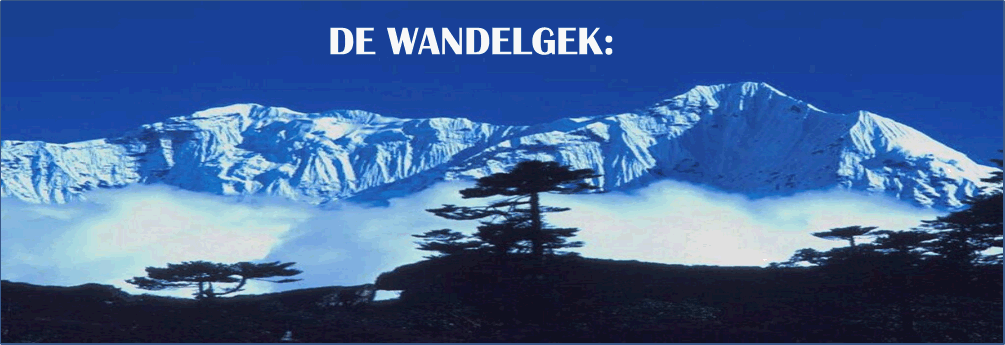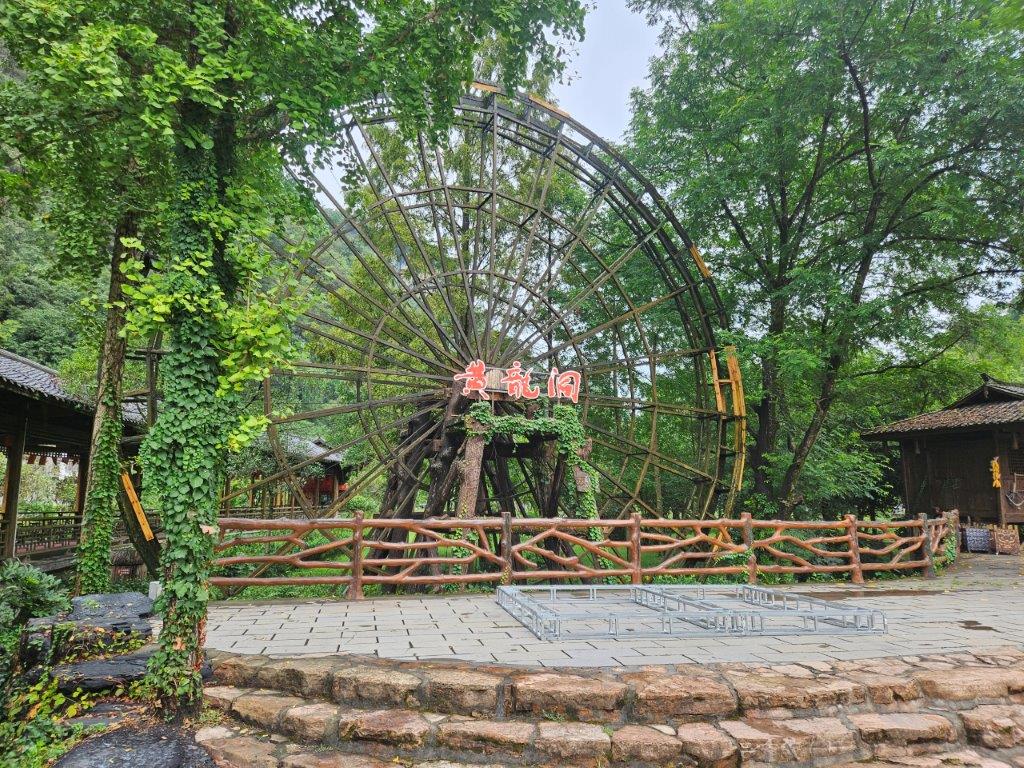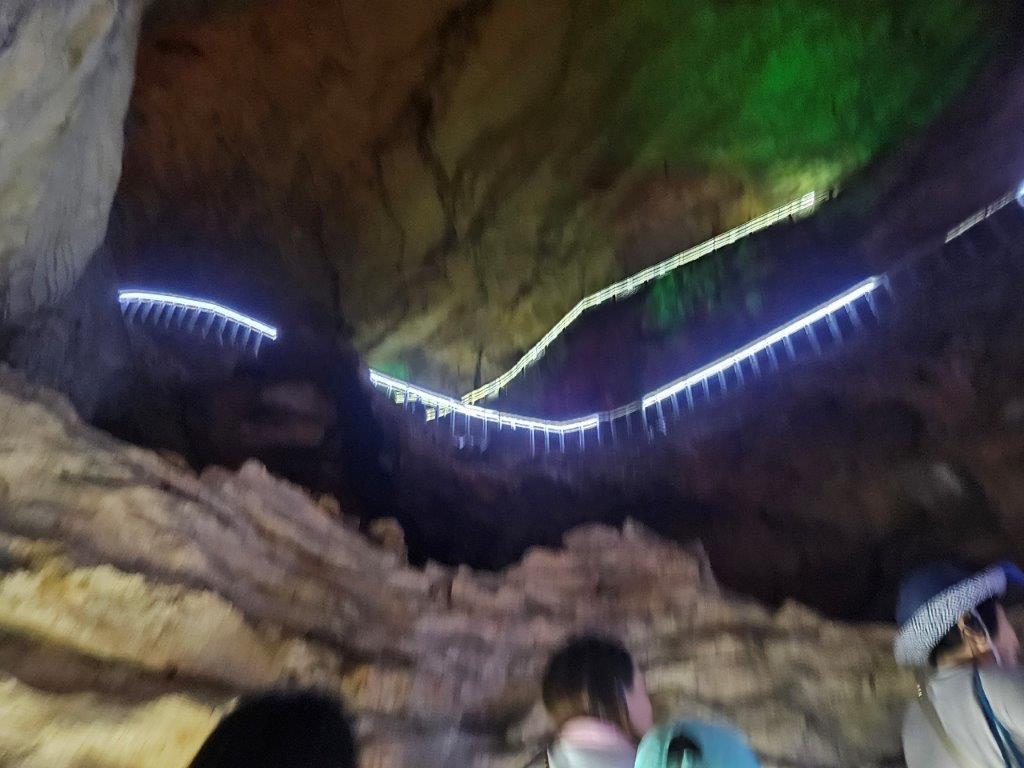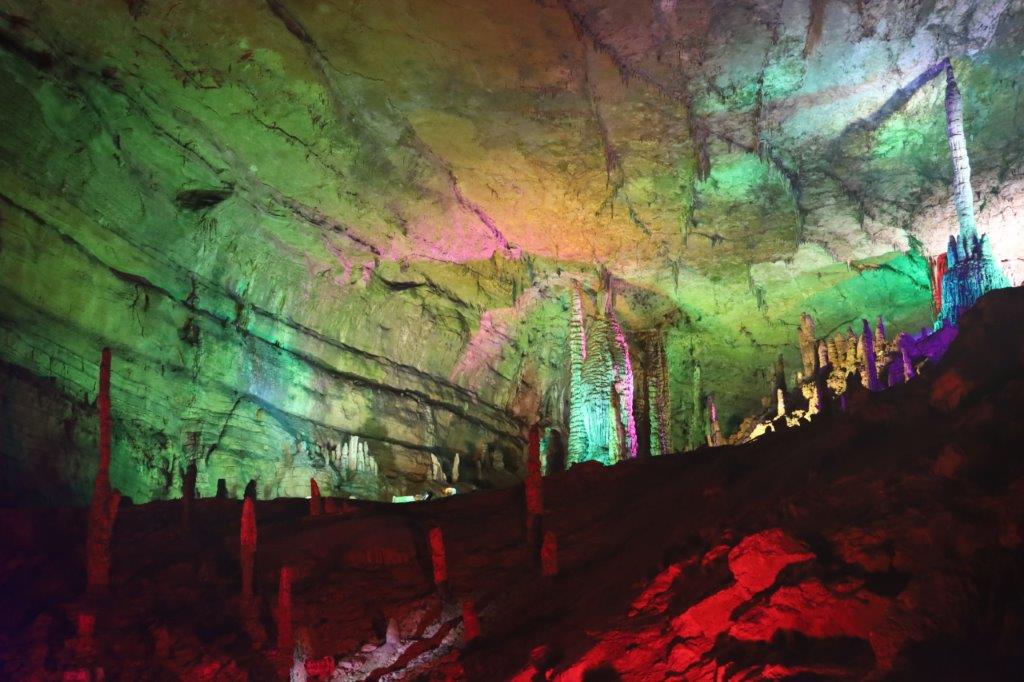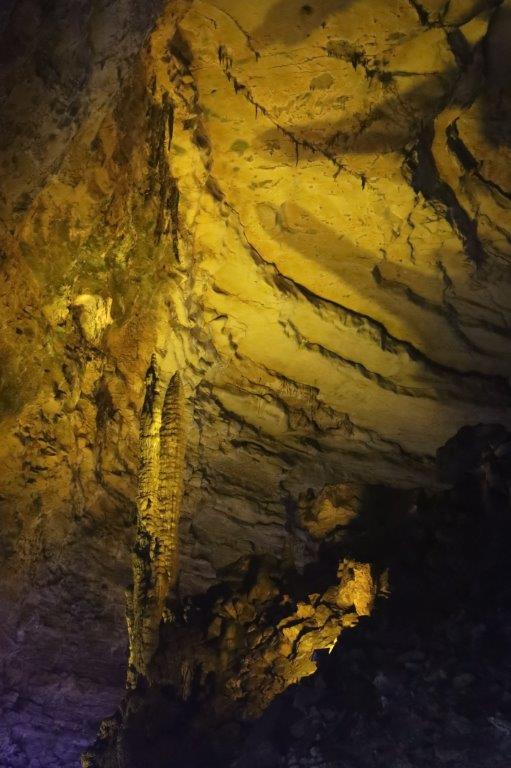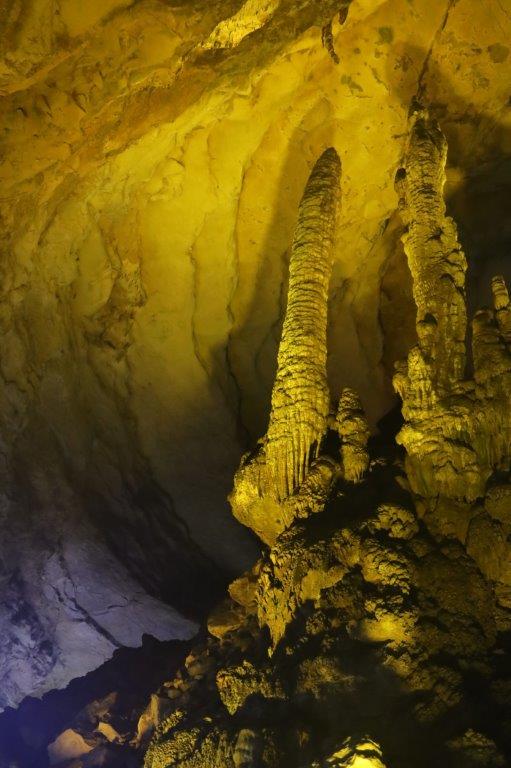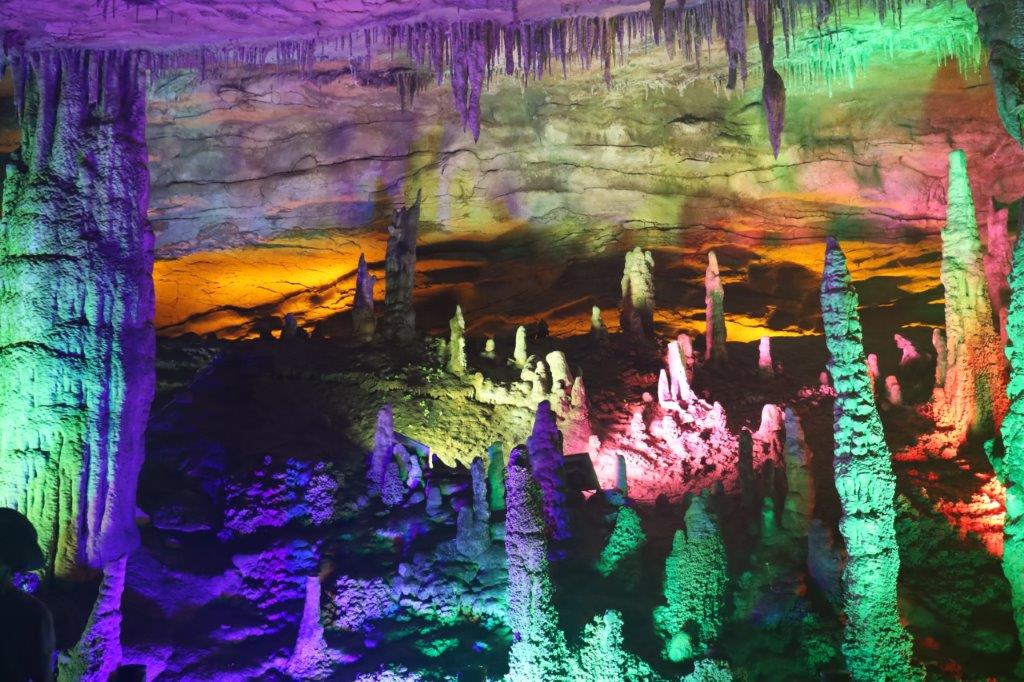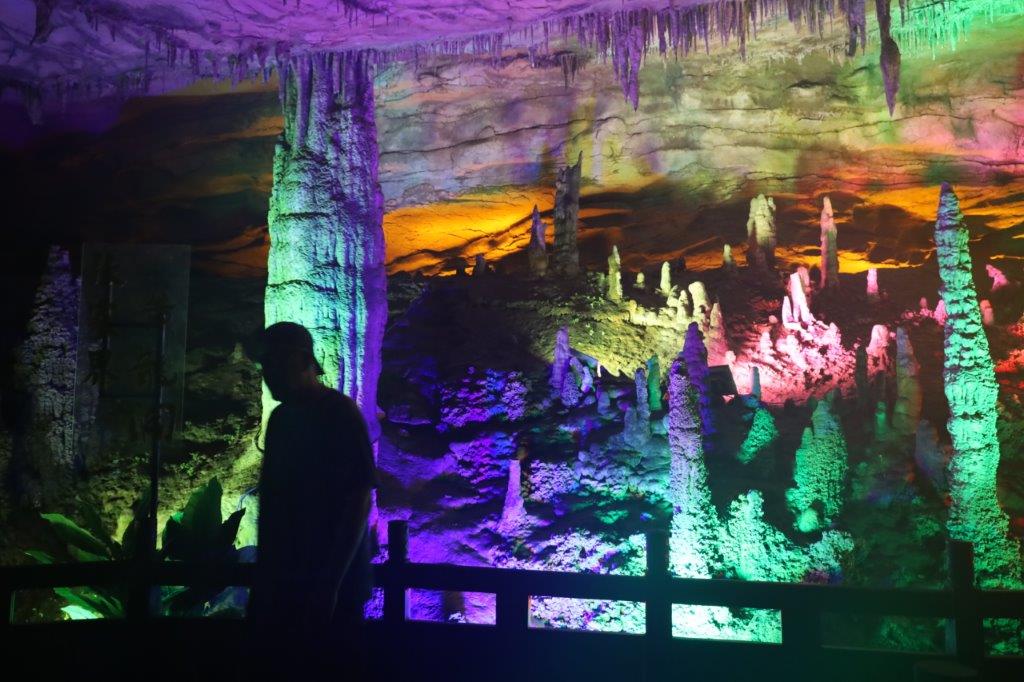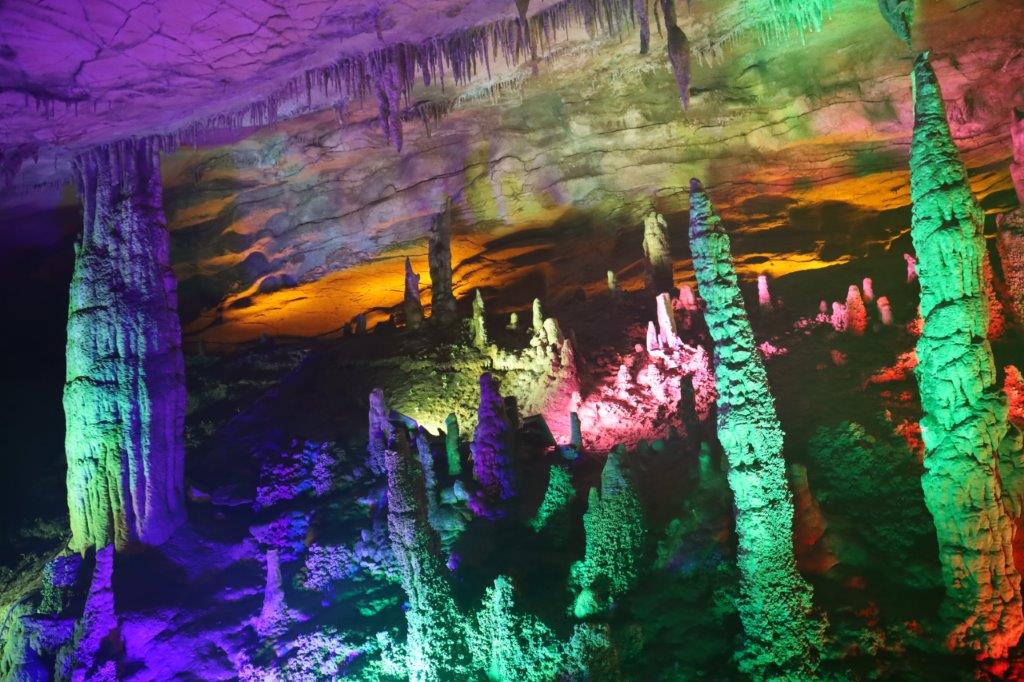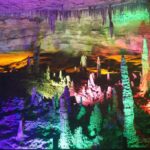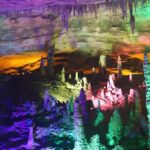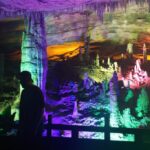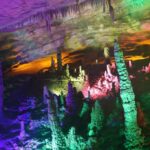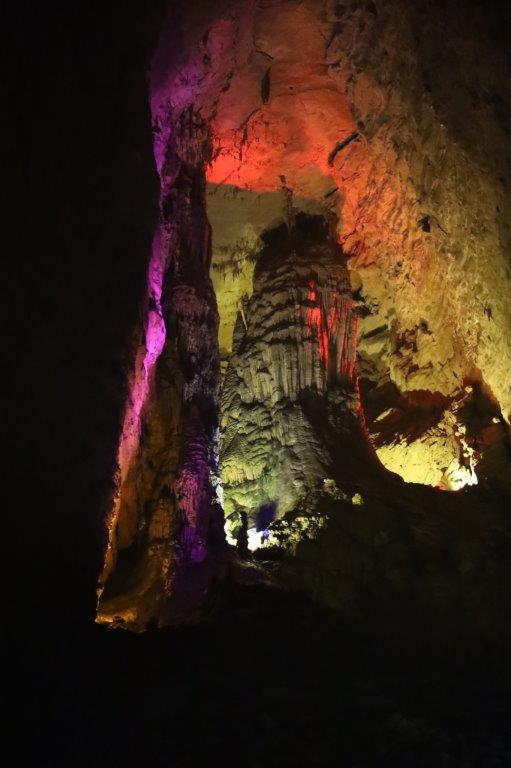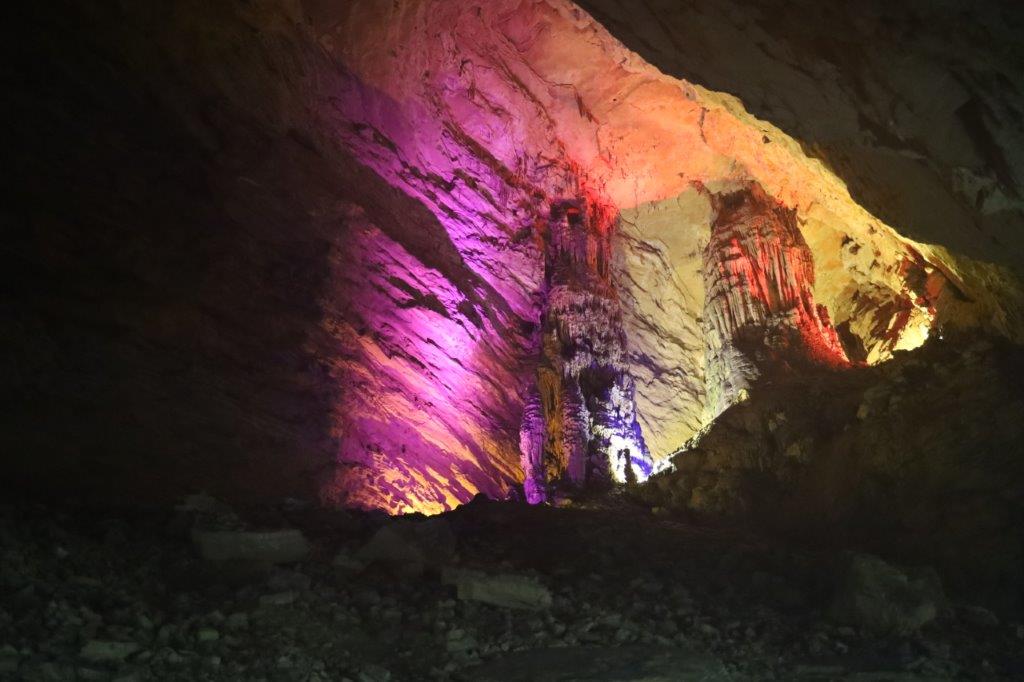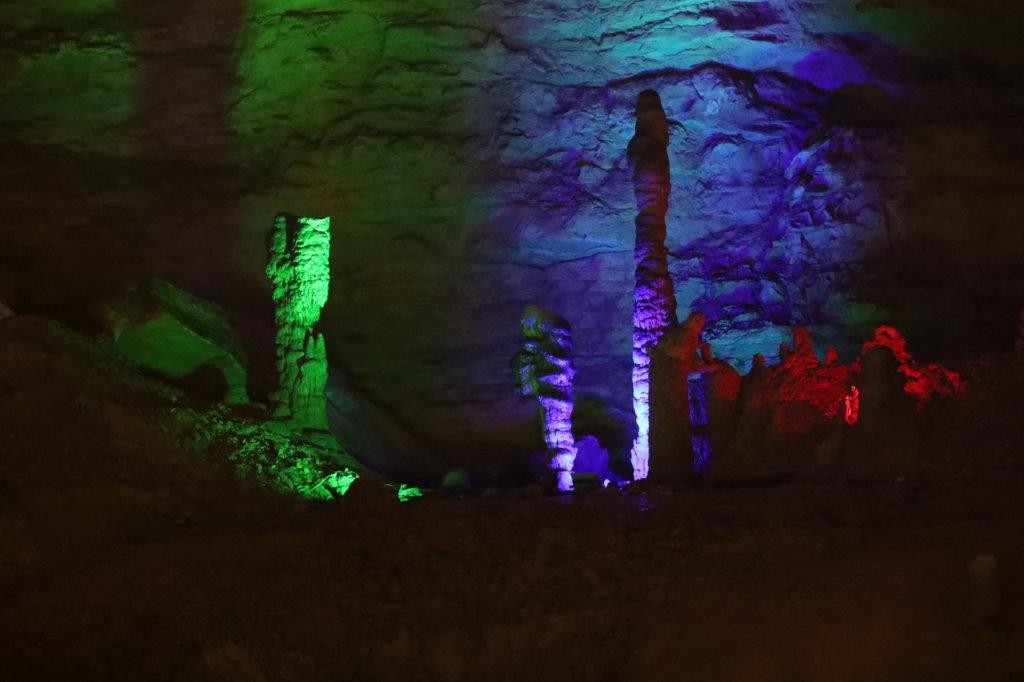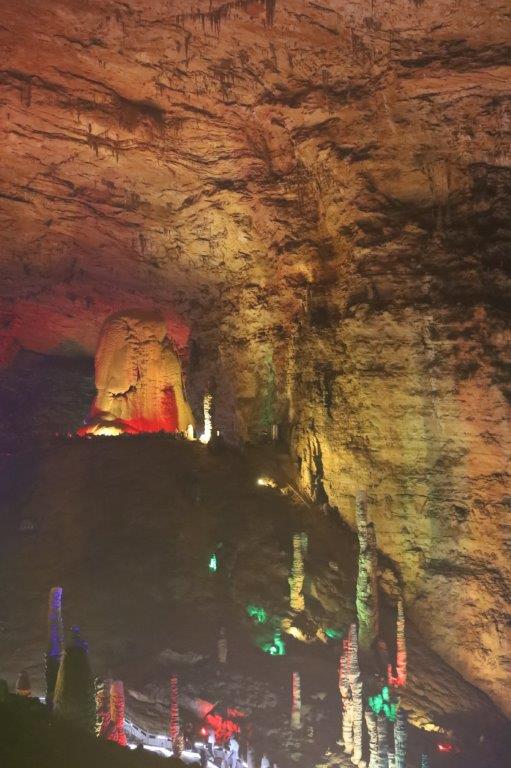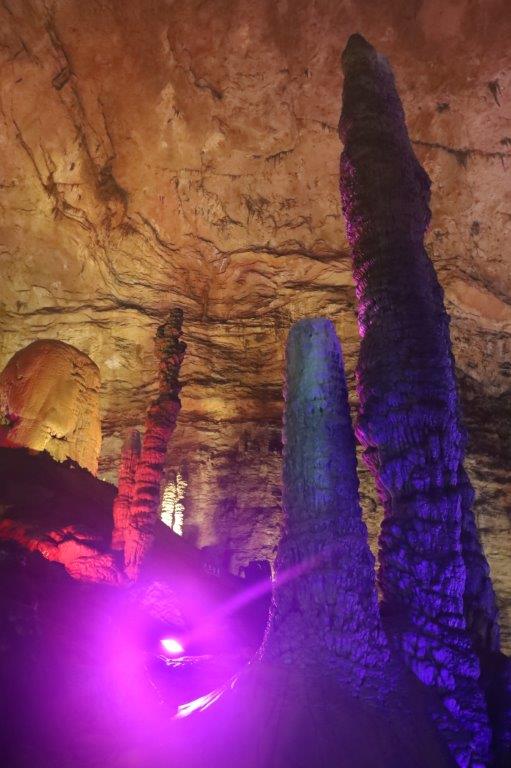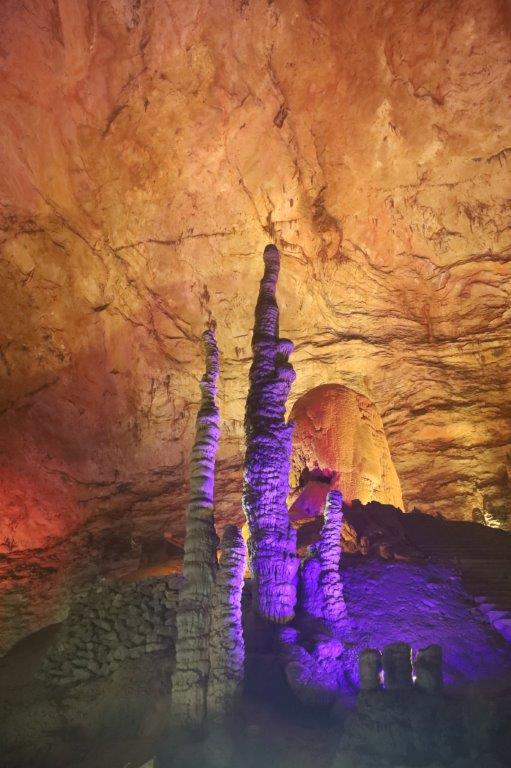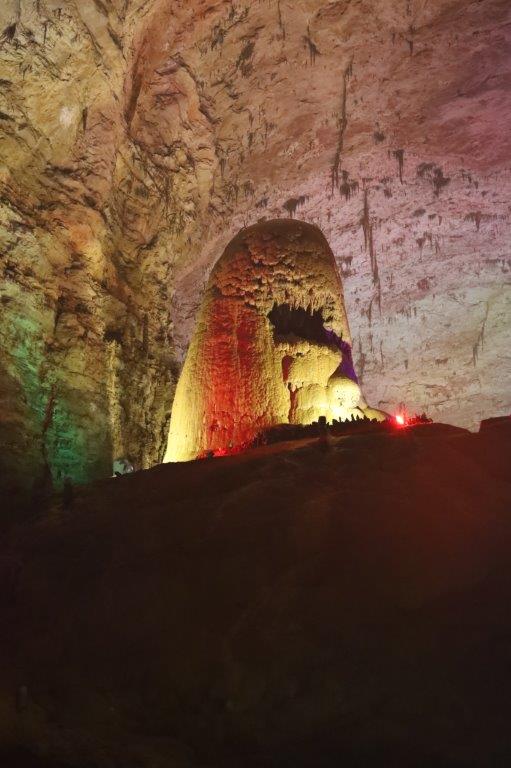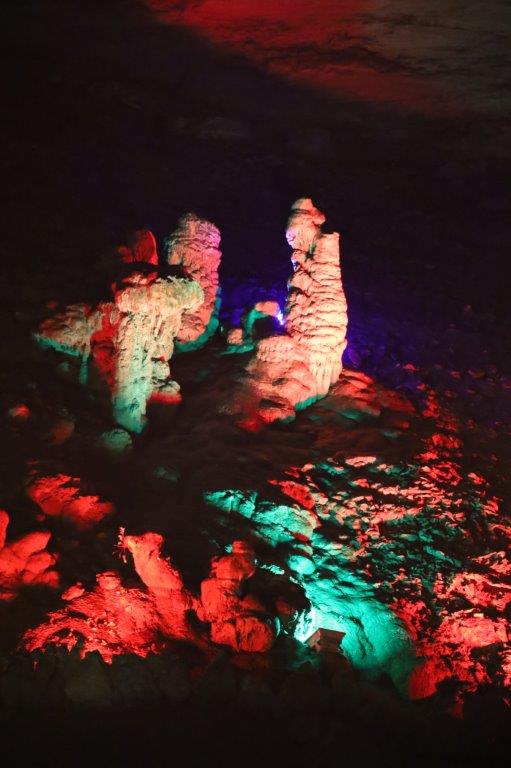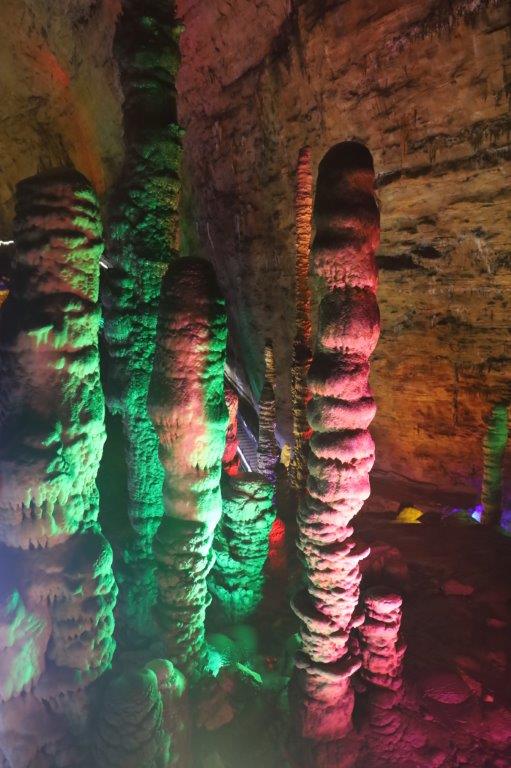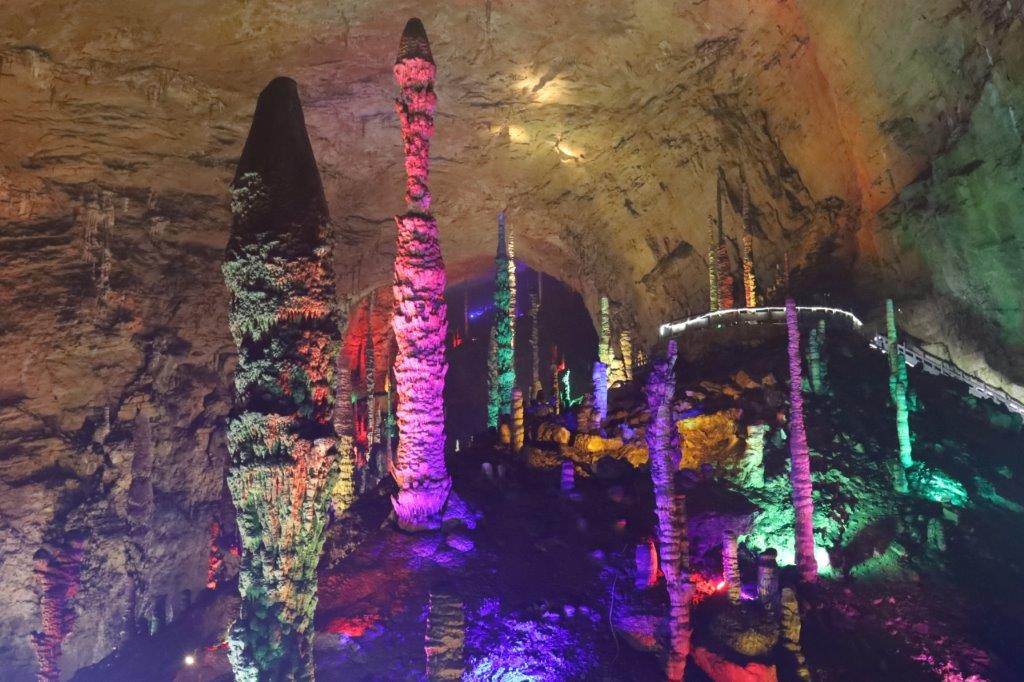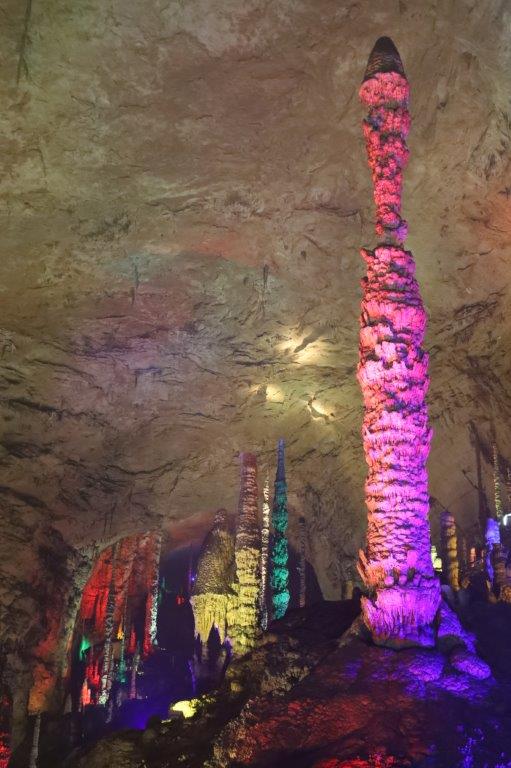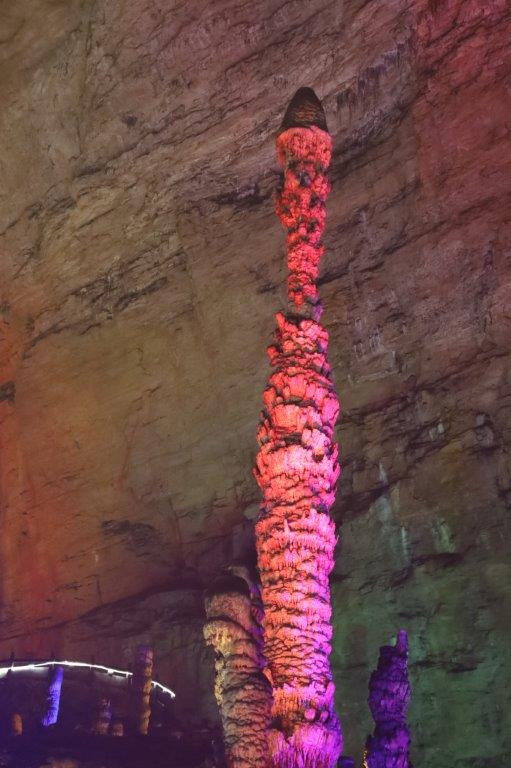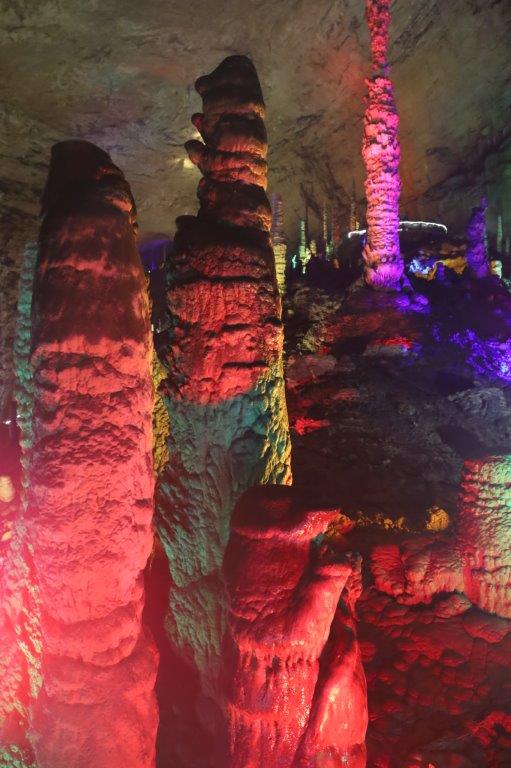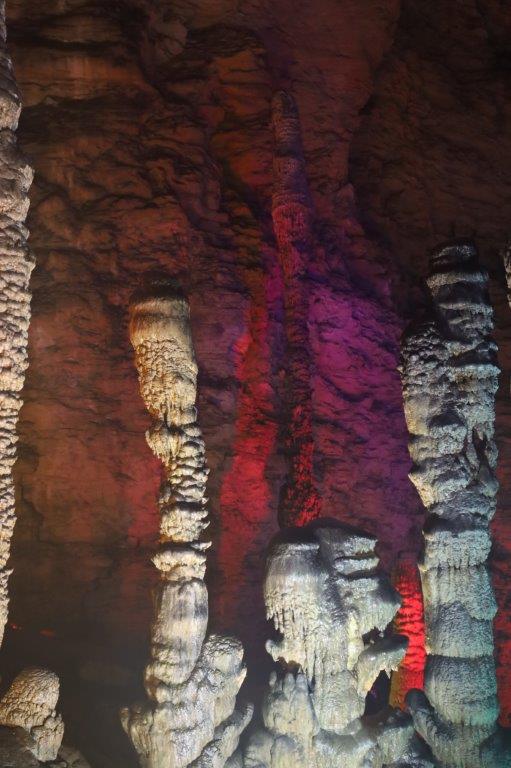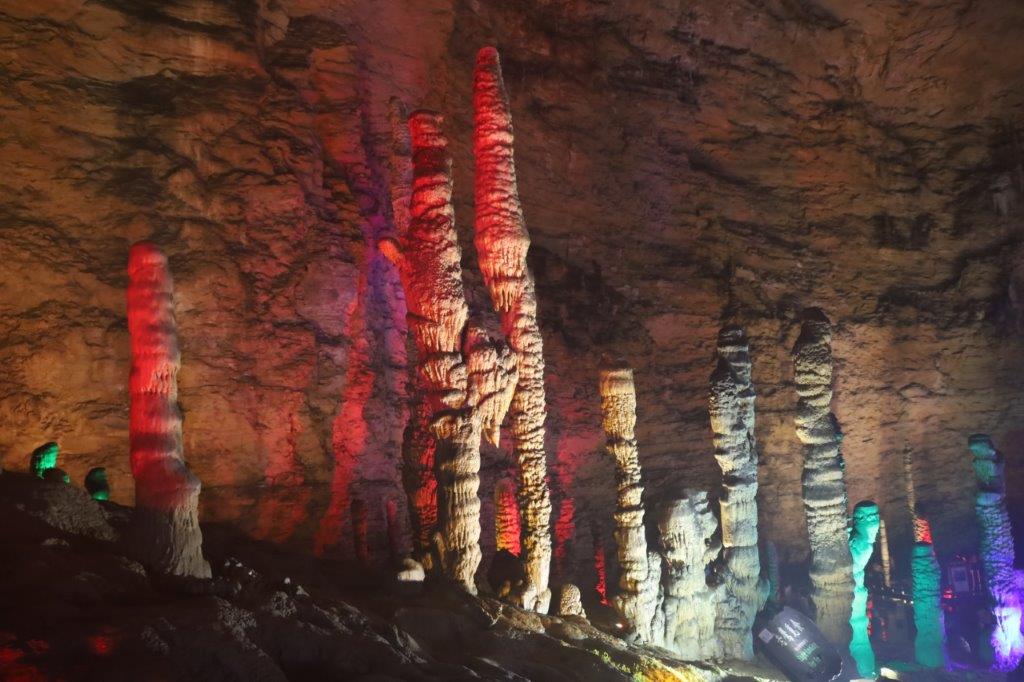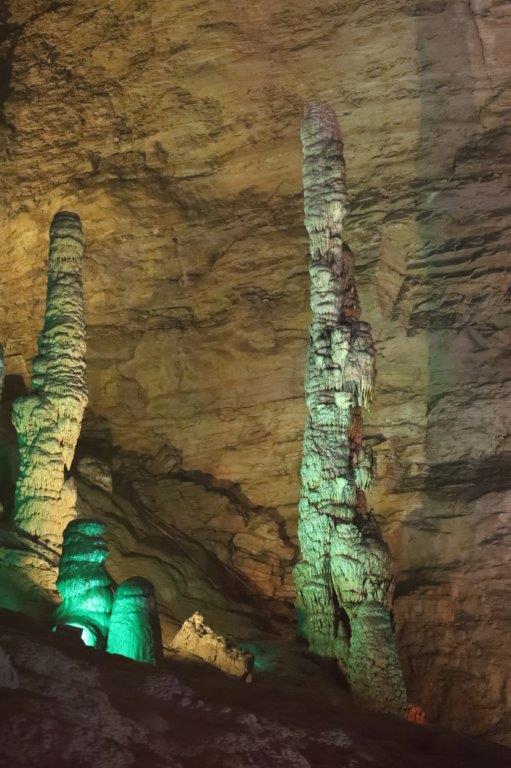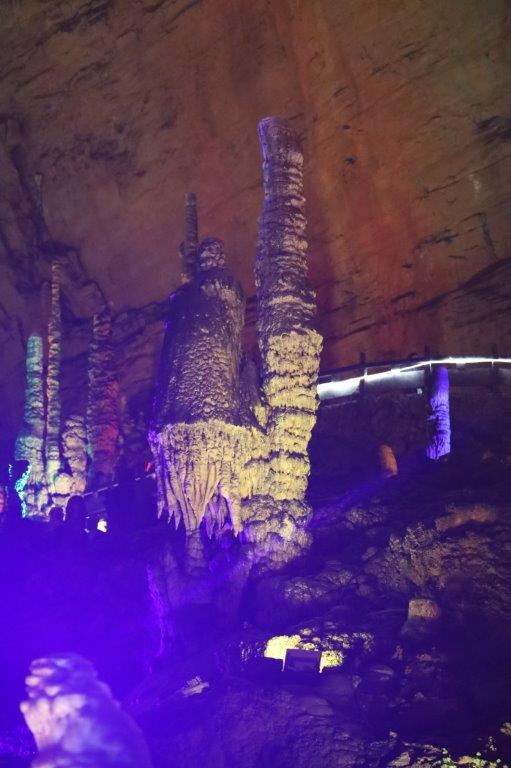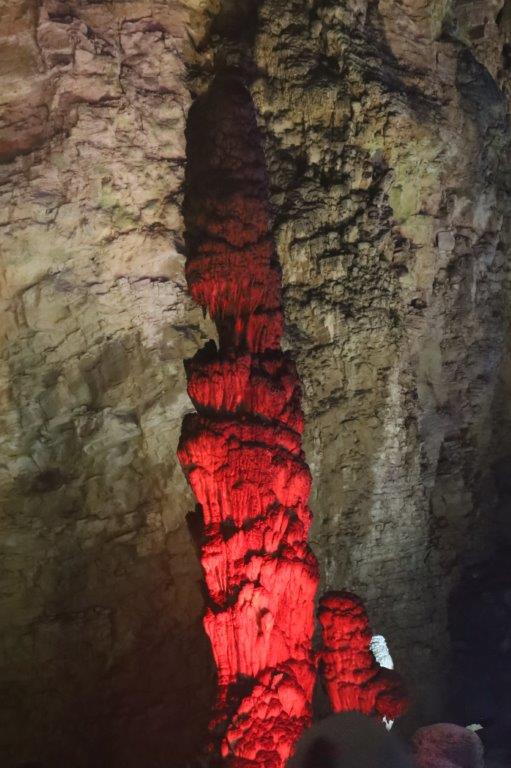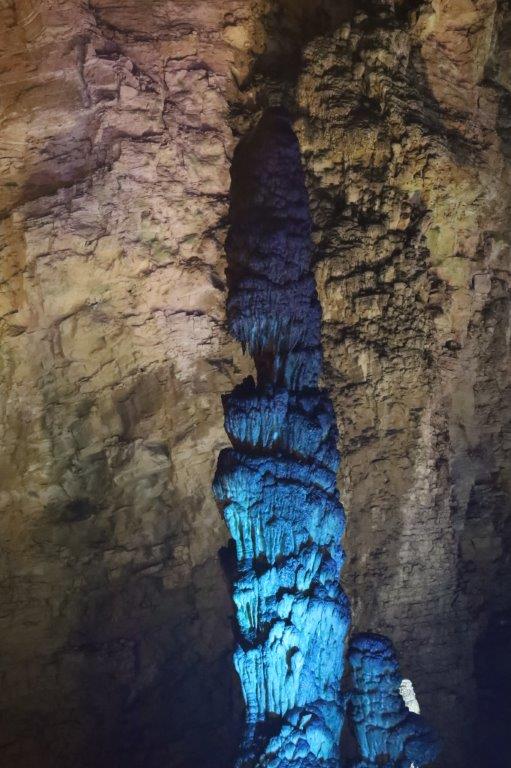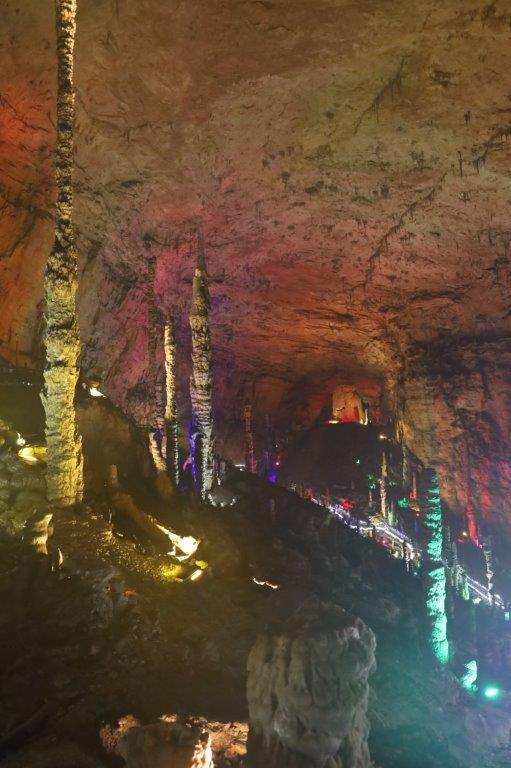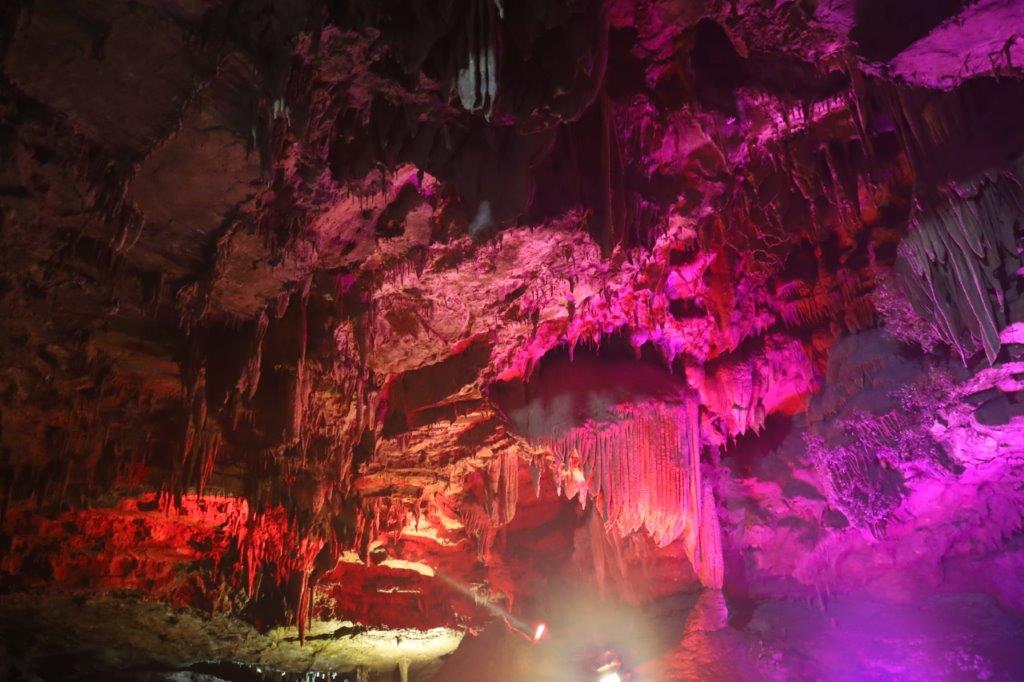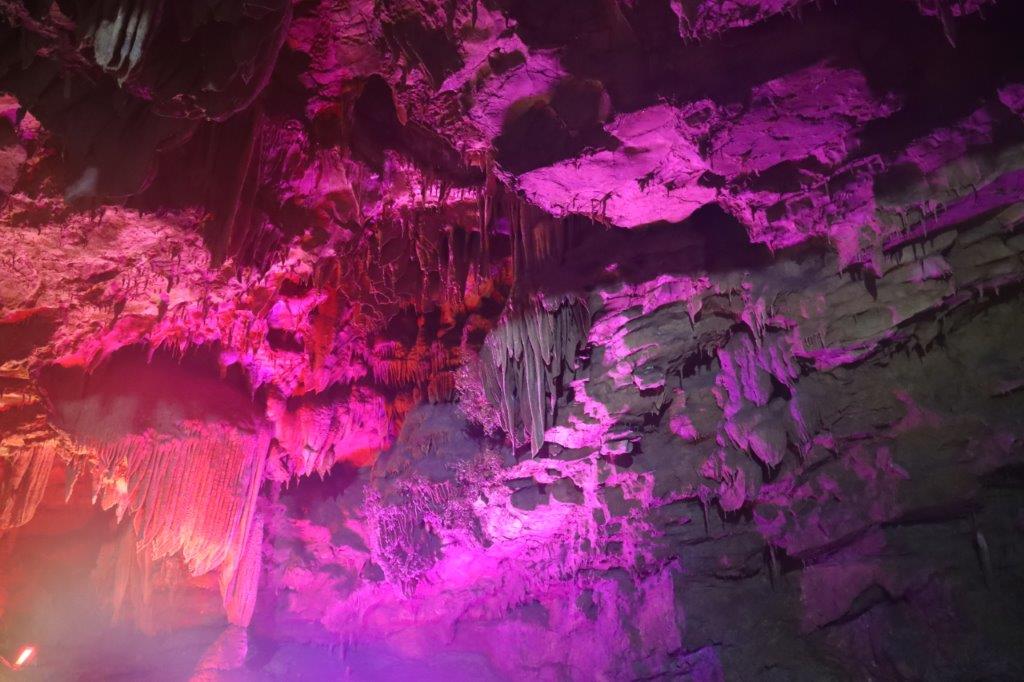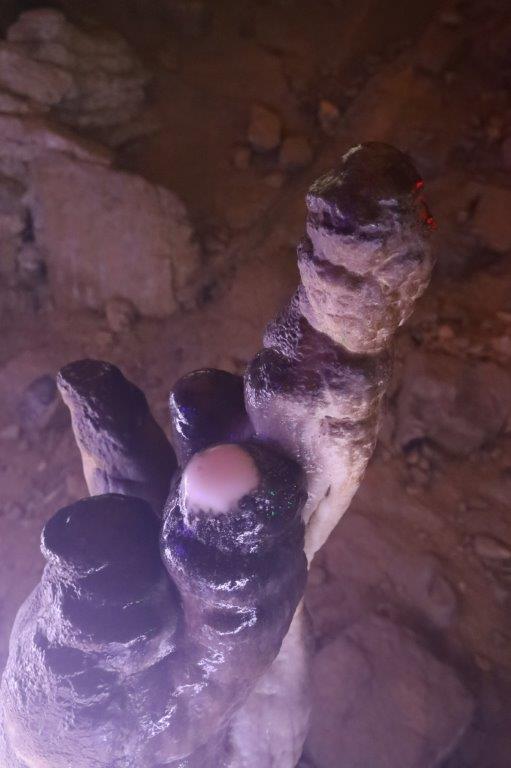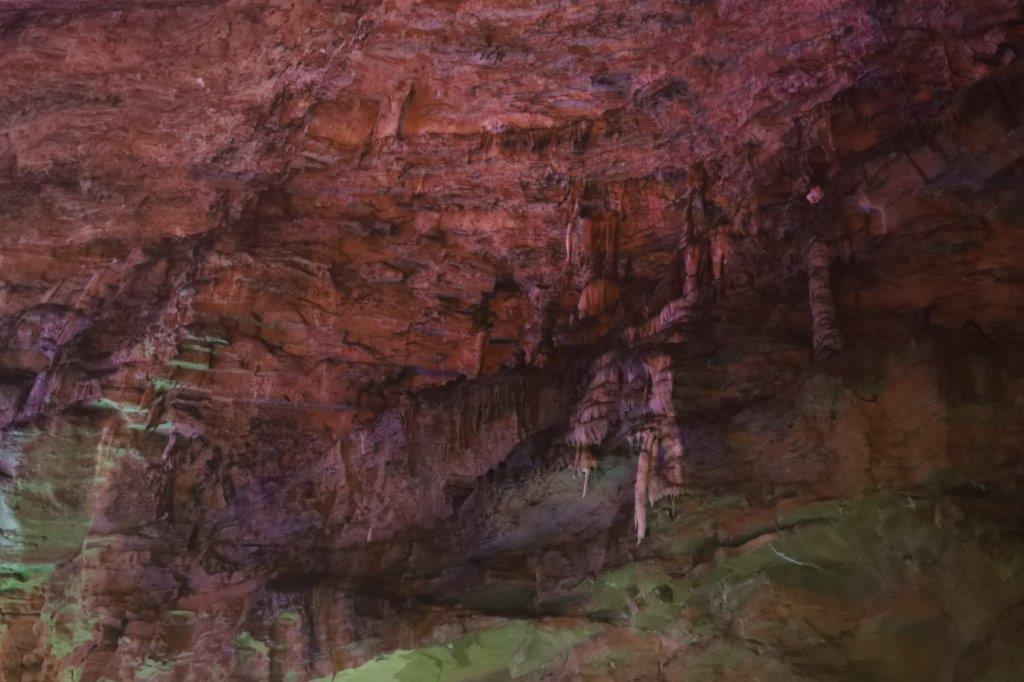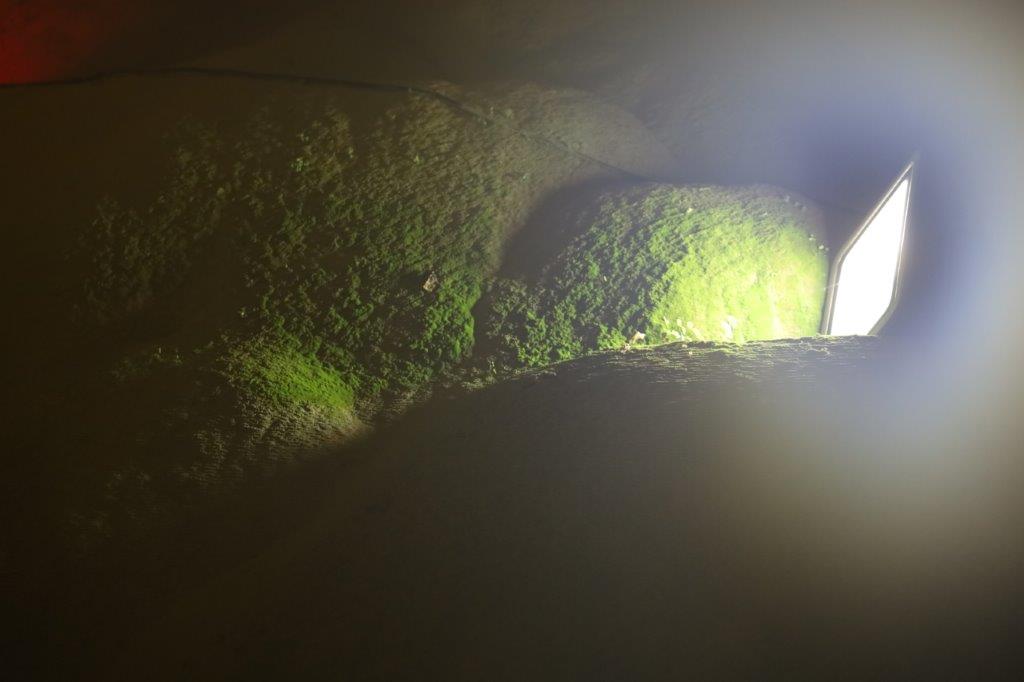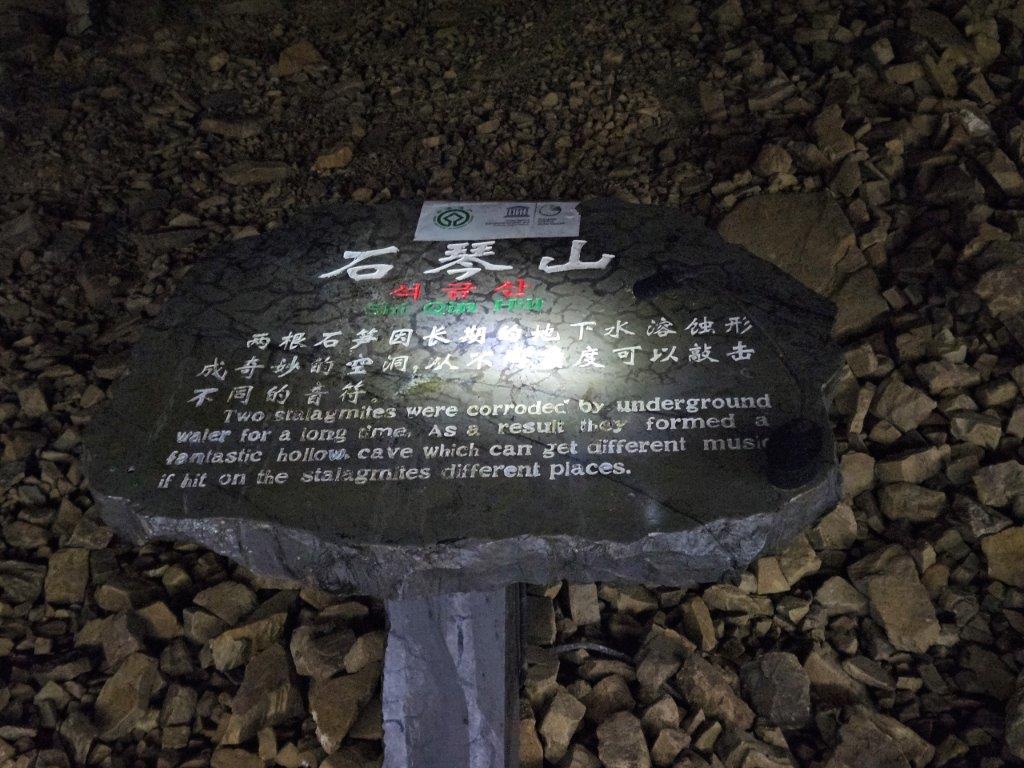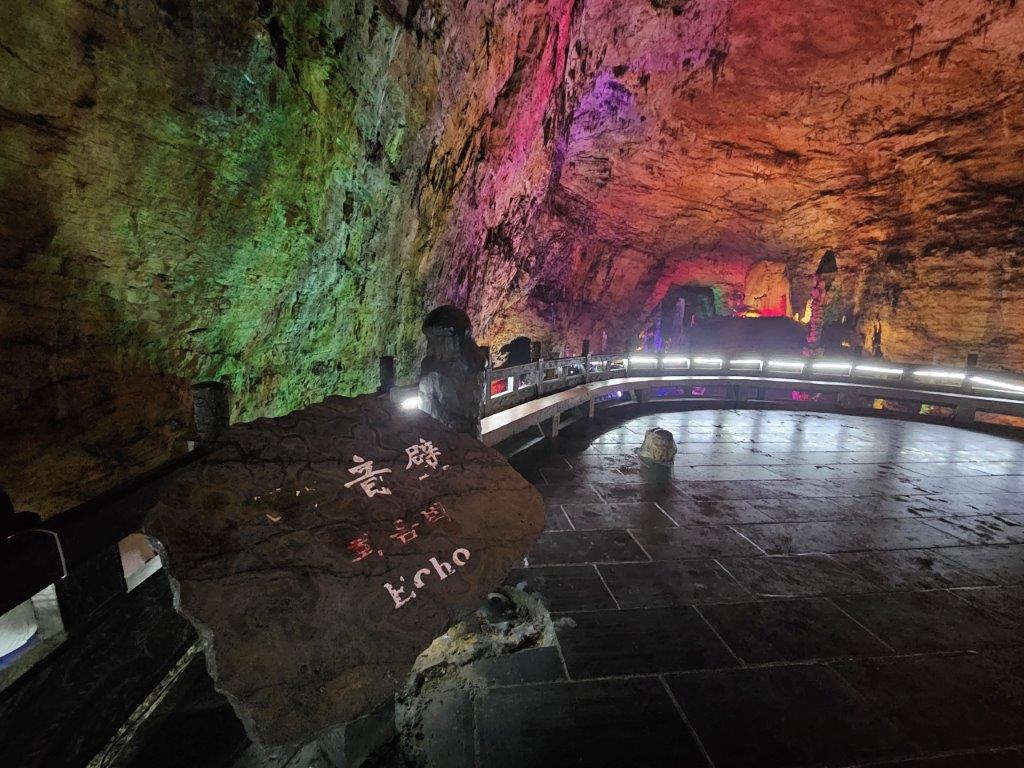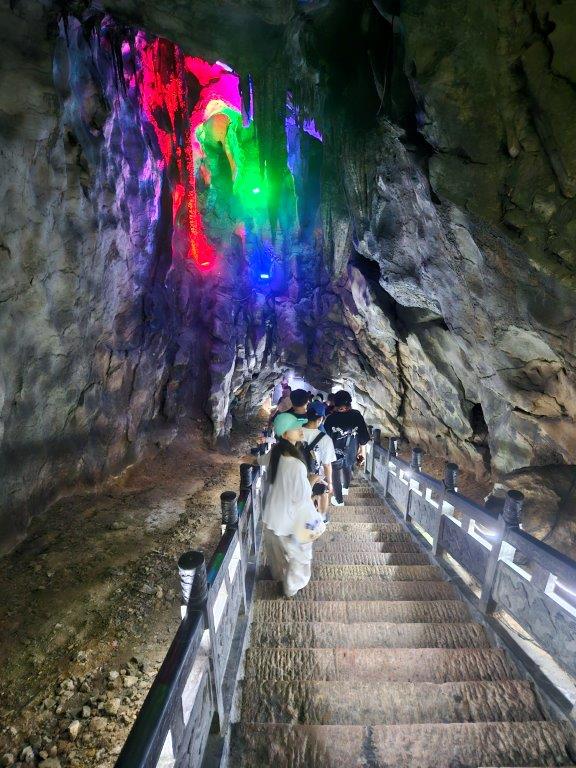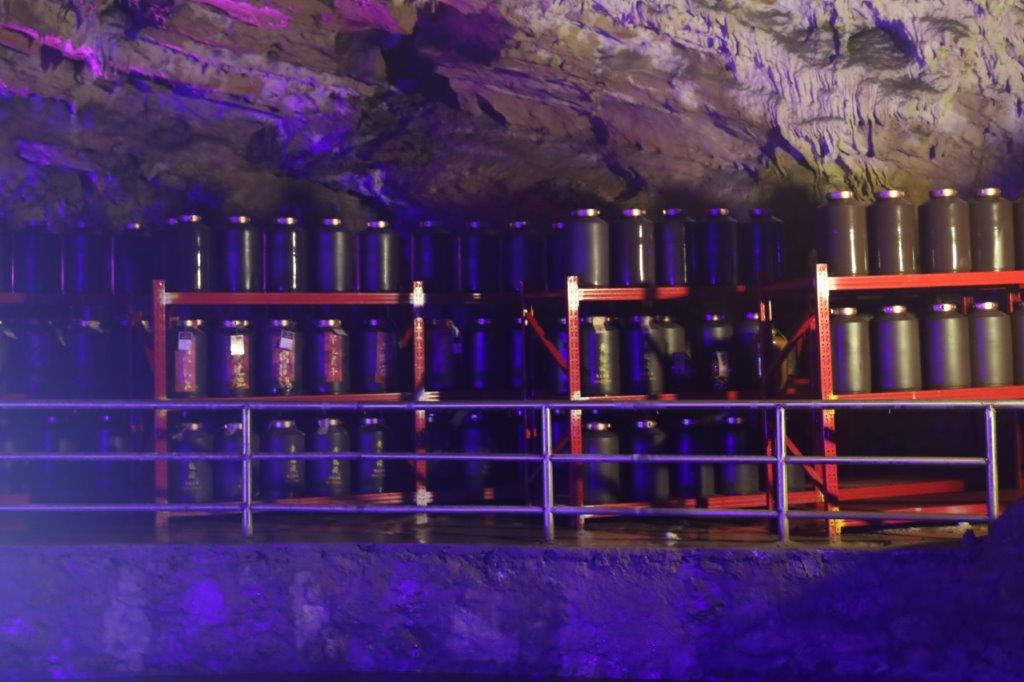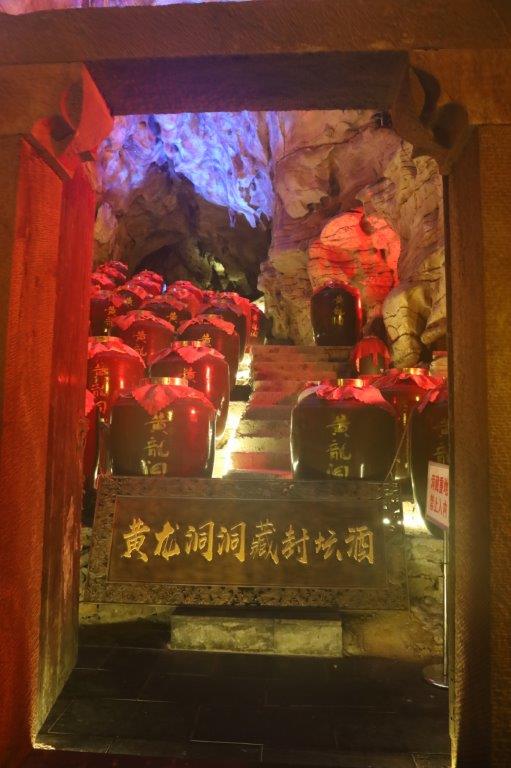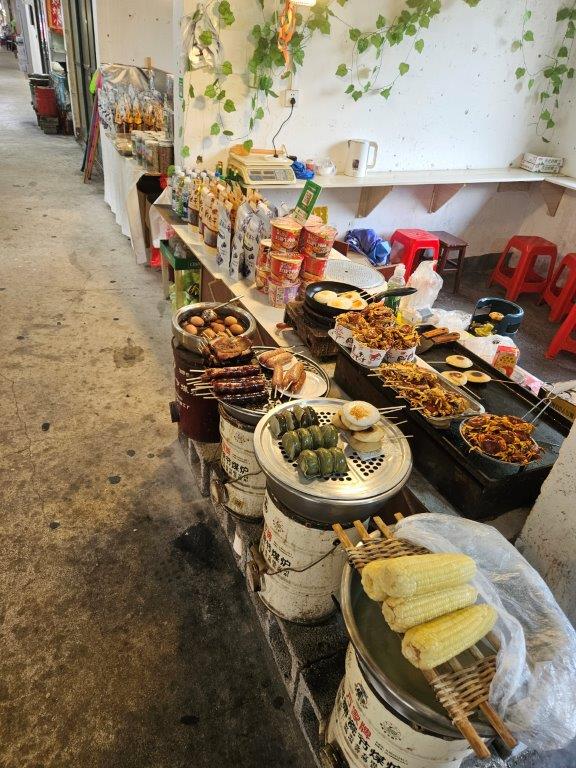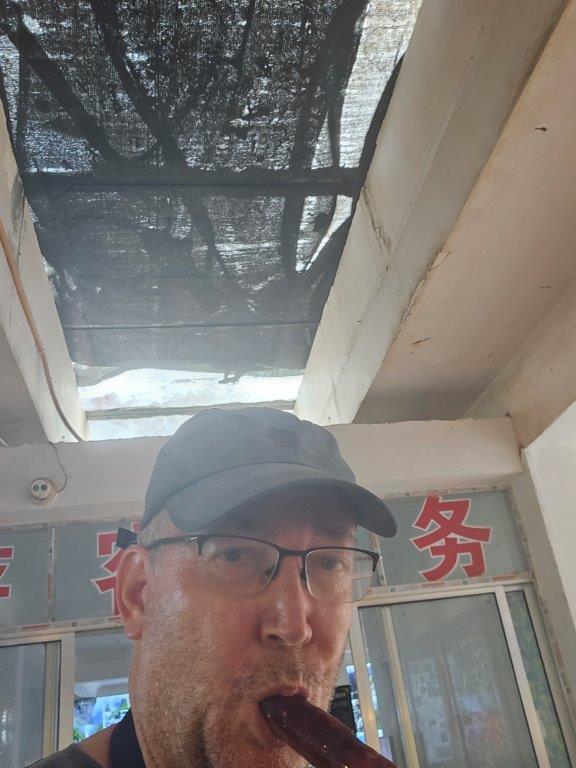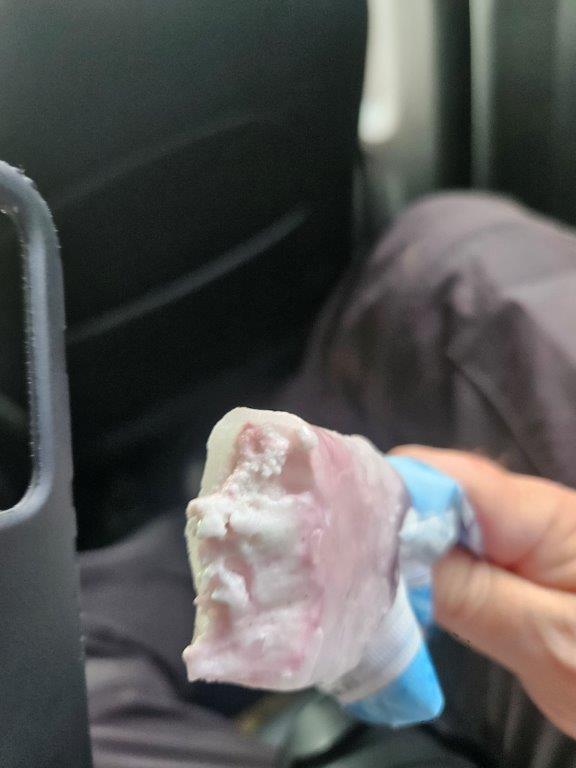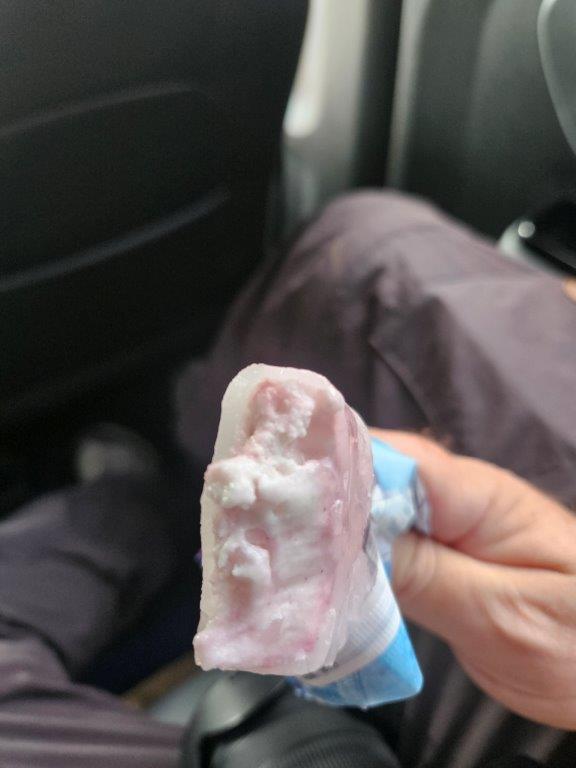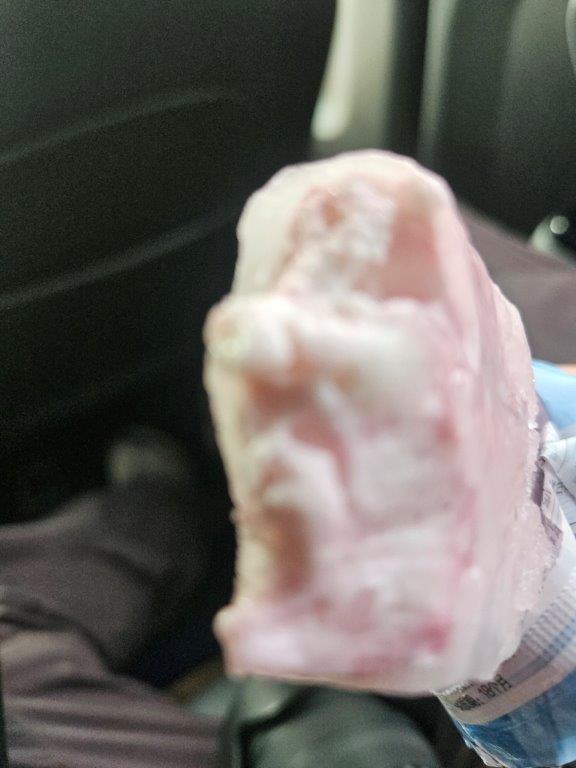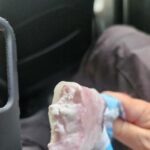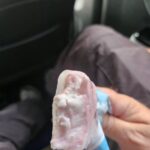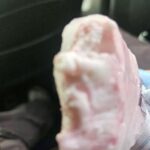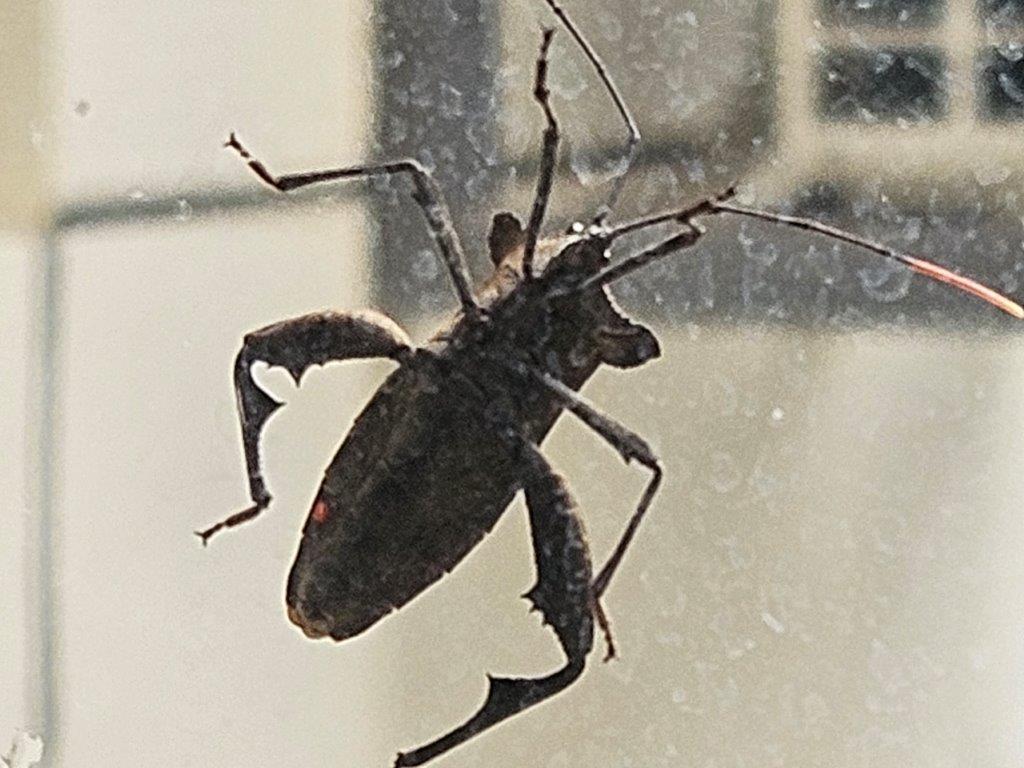18. China/Hunan: Huanglong Cave/Yellow Dragon Cave (Huanglongdong Scenic Area/Wulingyuan Scenic Area/Suoxi Valley Nature Reserve/Zhangjiajie National Forest Park / UNESCO World Heritage Site)
The distance from the Zhangjiajie Grand Canyon to the Huanglong Cave is about 27 kilometers.
The Suoxi Valley Nature Reserve (Suoxiyu) is located in the northeastern part of the Wulingyuan Scenic and Historic Interest Area in Zhangjiajie. Famous for its picturesque mountains, graceful rivers, deep caves and limpid streams, the nature reserve covers an area of 147 sq km, has more than 200 scenic spots, some famous include the Ten-mile Natural Gallery, Shuiraosimen, Baofen Lake, Yellow Dragon Cave, Baizhang Valley, etc. The scenery of the Suoxi Valley Nature Reserve is more energetic than that of Guilin and more attractive than the Stone Forest of Yunnan. Mountains and valleys nearby are covered by misty clouds.
As mentioned above, The Wandelgek was visiting the Yellow Dragon Cave or Huanglong Cave. In addition to the cave itself the Huanglong Cave Scenic Area includes Huanglong Cave Ecology Square, completed in 2009 by restoring the landscape of the area adjacent to the cave entrance…
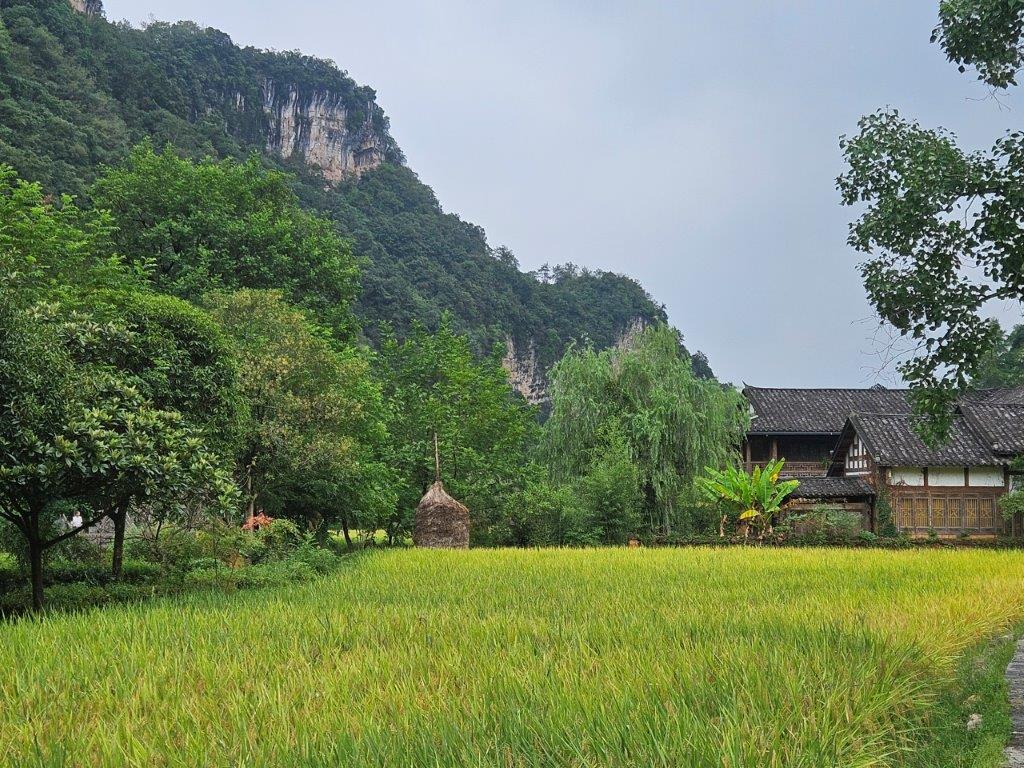 The effect of the restorations was quite beautiful, now showing visitors a rural setting with some traditional houses, traditional farming and examples of water mills used for irrigation.
The effect of the restorations was quite beautiful, now showing visitors a rural setting with some traditional houses, traditional farming and examples of water mills used for irrigation.
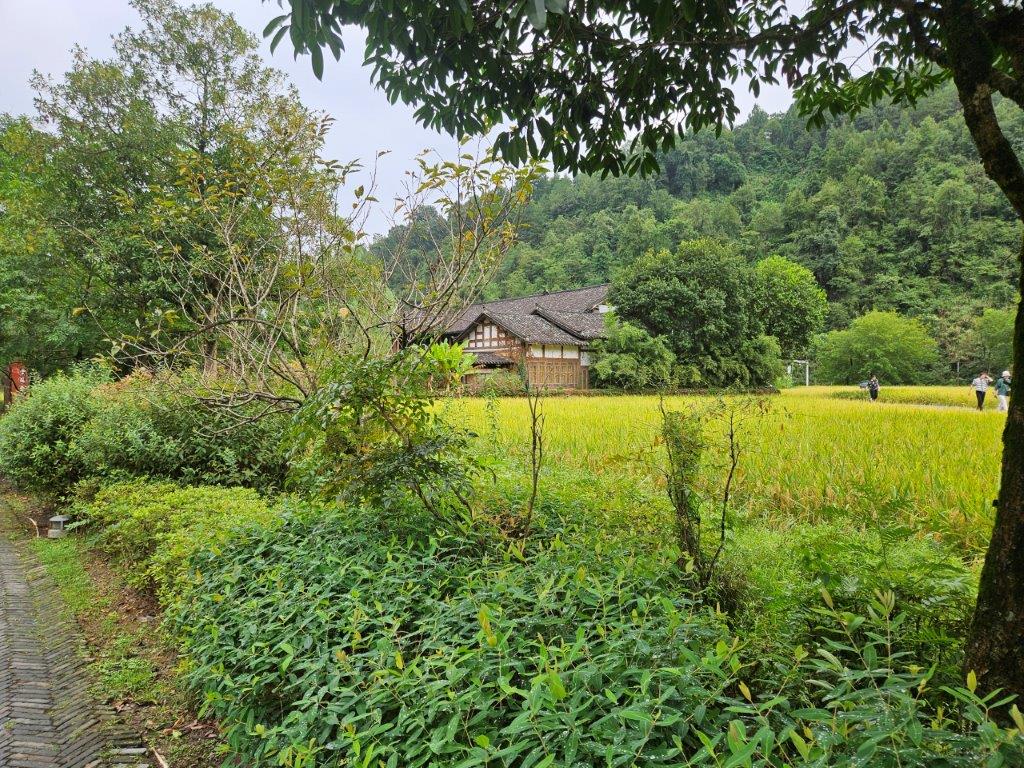 I loved how beautiful this was done.
I loved how beautiful this was done.
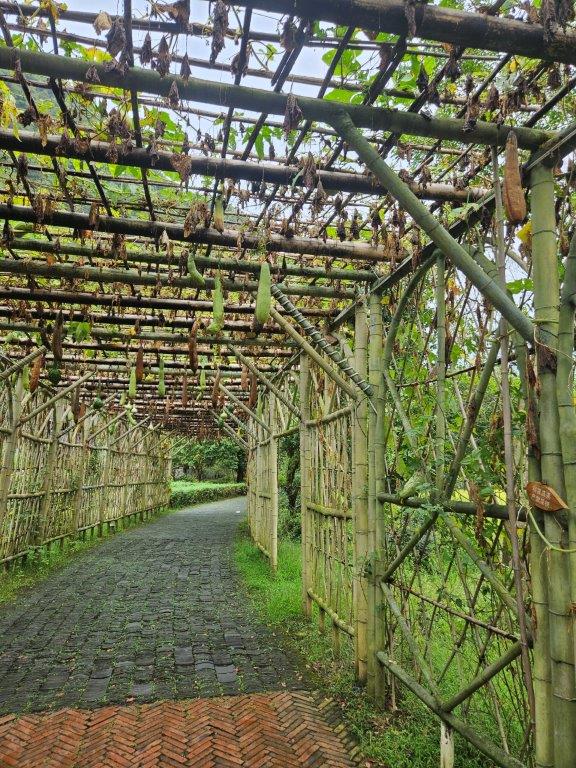 The pathway was running underneath arbours where kalabashes/gourds were hanging …
The pathway was running underneath arbours where kalabashes/gourds were hanging …
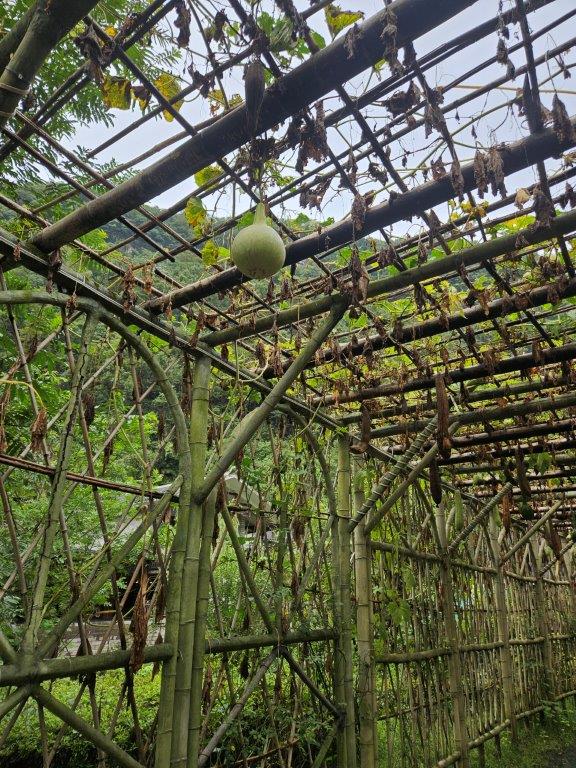 There was just before entering the caves, an area where samples of water mills were shown…
There was just before entering the caves, an area where samples of water mills were shown…
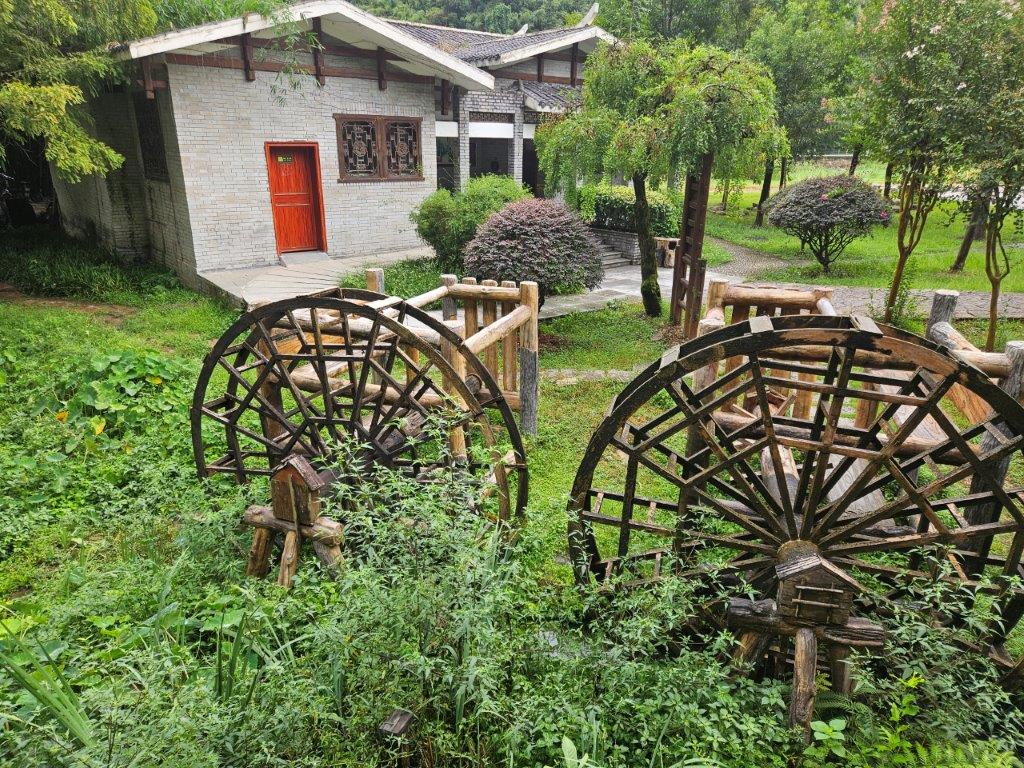 The ingenuity of these irrigation tools is fascinating and The Wandelgek would see some more when he visited rural areas of China further south …
The ingenuity of these irrigation tools is fascinating and The Wandelgek would see some more when he visited rural areas of China further south …
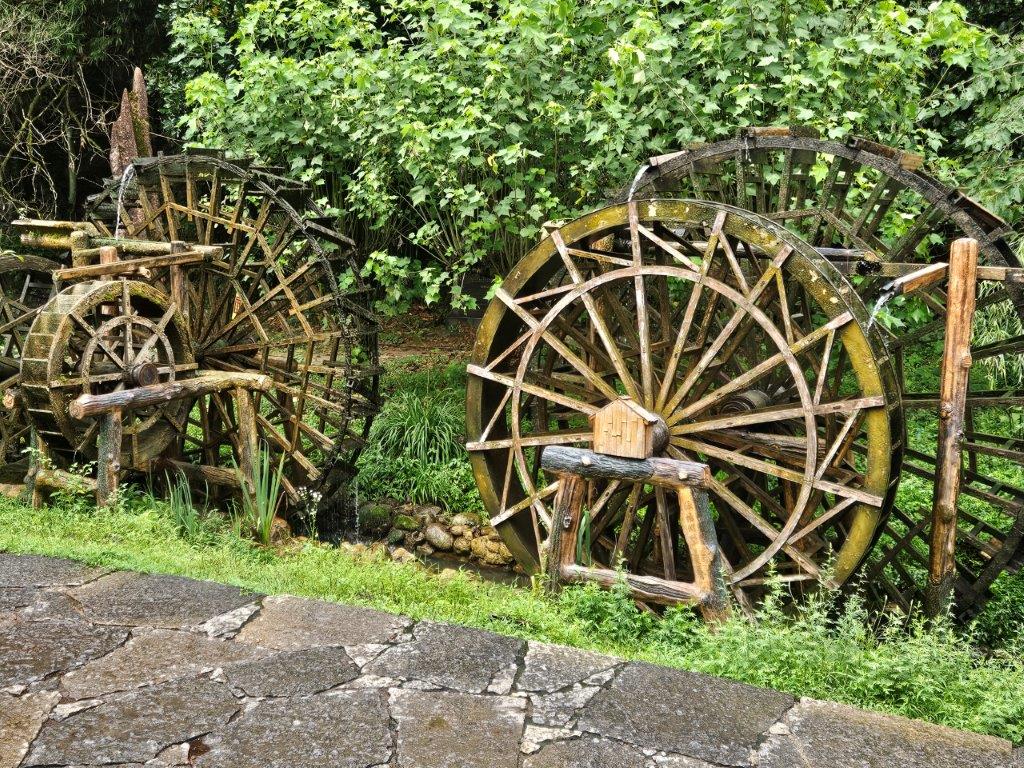 To show off a bit, there were some connected water mill wheels that through their spinning axes had effects upon eachother …
To show off a bit, there were some connected water mill wheels that through their spinning axes had effects upon eachother …
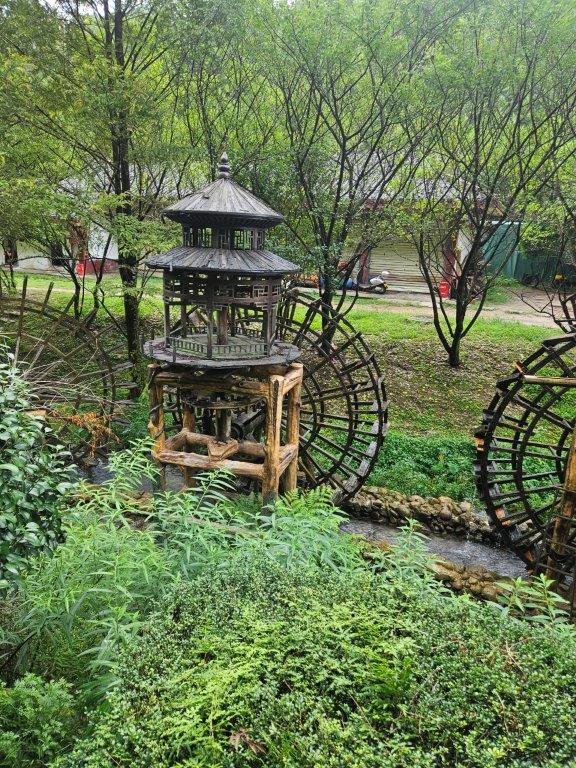 The little pagoda like structures on top e.g. are rotating …
The little pagoda like structures on top e.g. are rotating …
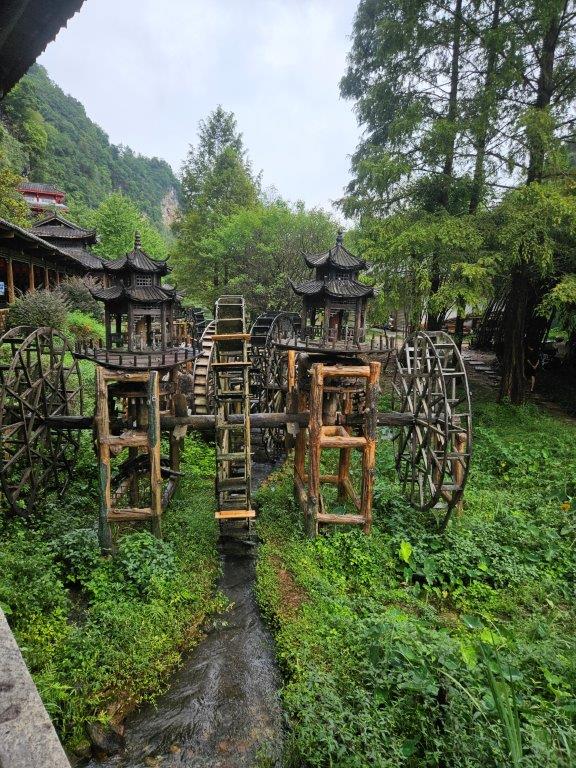 The water wheels are set into motion by the streaming water and through axes and gears this motion is transported to other wheels, some really large …
The water wheels are set into motion by the streaming water and through axes and gears this motion is transported to other wheels, some really large …
This reminded me of a beautiful movie scene I saw in an old Akira Kurosawa movie named Akira Kurosawa’s dreams…
The last section is about a watermill village.
In the village someone died and he or she is accompanied on their last journey by all the villagers.
As The Wandelgek, I set out to explore the legendary Yellow Dragon Cave, nestled in the hillsides of Jiaoerjian Mountain within the Wulingyuan Scenic Area. This vast karst wonder, also called Huanglong Cave, is famed for its labyrinthine chambers and surreal limestone formations shaped over millions of years.
The Yellow Dragon Cave is a karst cave in the limestone-covered, eastern part of Suoxi Valley Nature Reserve and is in fact a network of interconnected caves, some with underground lakes and streams that continue to erode away the soft, porous limestone. The Yellow Dragon Cave is huge, measuring some 15 kilometers in length and roughly 140 meters in height in its highest spot, and covering over 50 hectares in area.
Local legend tells of a terrible drought during the Qing Dynasty’s Qianlong period, when desperate villagers called upon the respected sorcerer He Junru. He and his followers entered the cave to pray for rain but mysteriously vanished, leaving the cave shrouded in fear and superstition for generations. No one dared enter until, after the founding of the People’s Republic of China, locals began to abandon old superstitions. In 1983, Mao Jinchu and a team of young militiamen braved the darkness, unveiling the cave’s secrets and opening it to the world.
Walking through Yellow Dragon Cave, I marveled at its four-layered structure—two dry and two water-filled levels—spanning over 100,000 square meters. The highlight was the Sea-Calming Needle, a slender 19.2-meter stalagmite, said to echo the legendary weapon of the Monkey King. The underground river, winding through the cave, offered a mesmerizing boat ride, revealing chambers adorned with colossal stalactites and sparkling waterfalls.
Today, Yellow Dragon Cave stands not just as a geological marvel but as a testament to the blend of myth, history, and natural beauty that defines this corner of Zhangjiajie. The Wandelgek’s journey here was a step into both legend and the breathtaking artistry of nature.
Then we arrived at the cave’s entrance.
A bit of Chinese language
Before visiting Huanglong cave, The Wandelgek visited Huangshan city and mountain. He already knew the word Shan means Mountain(s) like in Tien Shan, meaning Heavenly Mountains), which he visited in 2004
and here he learned the word Huang means Yellow.
In 2008, during a visit to Vietnam he learned about the importance of the word Long, which means Dragon.
So Huanglong cave means Yellow Dragon cave.
Huanglong Cave /Yellow Dragon Cave
Huanglong Cave or ‘yellow dragon cave’ is a huge karst cave located in Wulingyuan District, Zhangjiajie City, Hunan, People’s Republic of China and a national 4A rated scenic area. As of 2010, the cave has over a million visitors per year. Since 1997, the Huanglong Cave scenic area has been managed by Beijing-based China Datong Co. Ltd. It was previously managed directly by the Hunan provincial government.
The Yellow Dragon Cave in the Wulingyuan Scenic Area of Zhangjiajie is an underground karst cave with typical karst landform. The highest point of the cave has a vertical height of 140 meters. It is well known for the broad and high inner space, deep and quiet subterranean river, impending waterfalls and dense stalagmites. The cave was rated as the most beautiful karst cave in China in 2005 and was probably the largest karst cave in the world.
Covering a total area of 48 ha (120 acres), the cave system extends to 15 km (9.3 mi) in length and is divided into dry and wet levels. There are four levels, thirteen chambers, three underground waterfalls, two underground rivers, three pools, ninety-six passages, as well as an underground lake. The largest chamber in the cave is 4,000 m2 (43,000 sq ft) and the highest of the three waterfalls is 50 m (160 ft) high. The guided tour through the cave lasts about two hours and includes a boat ride down one of the underground rivers. There are actually 2 possible tours, a shorter one and the long one. The Wandelgek went for the long one which was going from entrance level to the topmost level accessible for visitors and then down tobbelow entrance level. As this cave really was huuuuuuuge, this meant a lot of ascending and descending on pathways and stairs.
This was the most spectacular cave The Wandelgek had ever seen and probably the largest too.
Huanglongdong has four floors containing: 1 reservoir, 2 underground rivers, 3 underground waterfalls, 4 pools, 13 halls and 96 entryways to the inside.
The underground river
The guided tour through the cave lasts about two hours and includes a boat ride down one of the underground rivers…
Boat Ride Into the Cave
The Wandelgek began his adventure at the entrance to the Xiangshui River, stepping into a small jet boat to glide into the heart of Yellow Dragon Cave.
It was a tranquil boat ride along the Echoing Water River, where the sound of flowing water echoed through the cave’s labyrinthine depths. The underground river, stretching 2,800 meters with an average depth of 6 meters and a year-round temperature of 16°C, set a mysterious tone for the trip. The 800-meter boat cruise, lasting about 10 minutes, passed wonders like the Golden Helmet of the Dragon King and the Goddess Bridge. Along the way, the flickering lights and the gentle sway of the boat created a sense of traveling back to ancient times, while glimpses of rare creatures such as the giant salamander and glassy fish added to the magic.
Exploring the Maze
Disembarking, The Wandelgek entered the Maze, the deepest and most intricate part of the cave.
Ascending to the Dragon Palace
Continuing upward, The Wandelgek reached the Dragon Palace, the oldest and largest hall of Yellow Dragon Cave, covering 14,000 square meters with an average height of 40 meters. This cavern, formed 200,000 years ago, houses 1,705 stalagmites—516 of which are over 1 meter tall. Among the highlights were the Sea Suppressing Needle (the cave’s tallest stalagmite at 19.2 meters, slender and seemingly fragile), the Throne of the Dragon King, and the ancient Cedar of Ten Thousand Years. The Sea Suppressing Needle, a true icon, has even been insured for 100 million Chinese Yuan to ensure its protection.
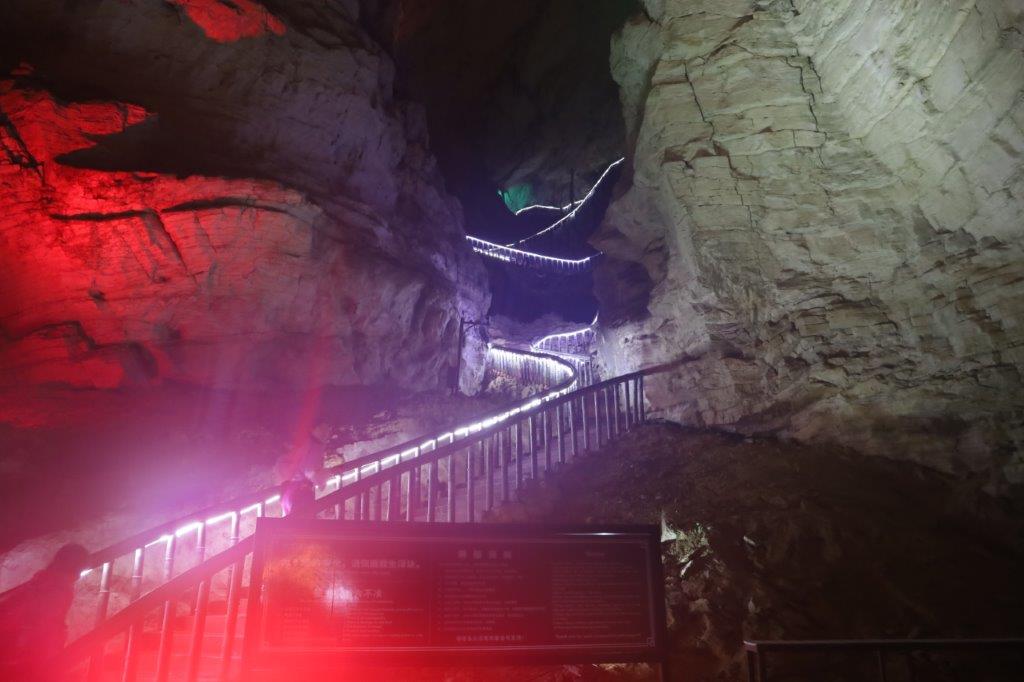 The climb is quite long and this is what makes this route a lot heavier than the the one the other way around which goes up more gradually …
The climb is quite long and this is what makes this route a lot heavier than the the one the other way around which goes up more gradually …
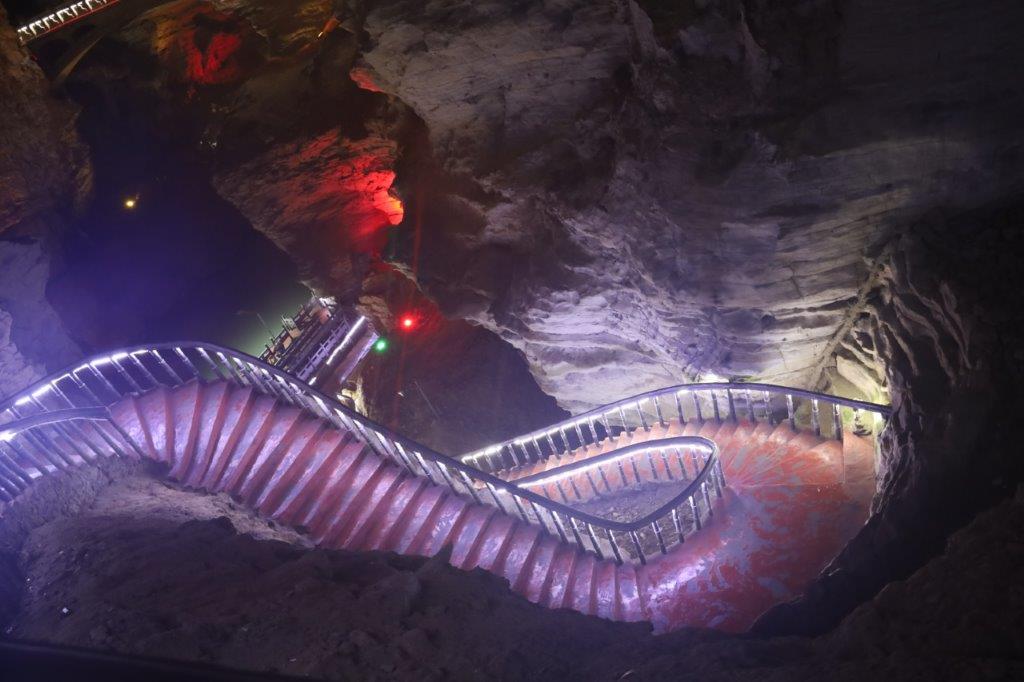 The views upon these seemingly neverending stairs does make you marvel about the architect’s ingenuity.
The views upon these seemingly neverending stairs does make you marvel about the architect’s ingenuity.
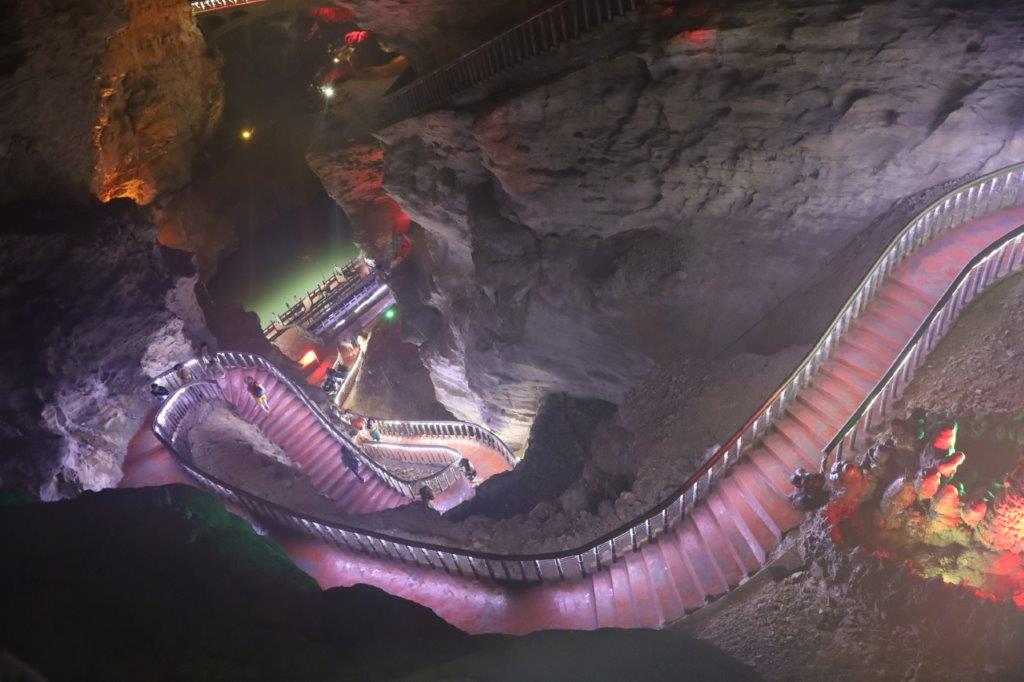 The Wandelgek ventured deeper into the legendary Yellow Dragon Cave of Zhangjiajie and was instantly struck by how thoughtfully developed it is for explorers—every walkway, step, light, and sign is meticulously designed, making the journey both accessible and atmospheric.
The Wandelgek ventured deeper into the legendary Yellow Dragon Cave of Zhangjiajie and was instantly struck by how thoughtfully developed it is for explorers—every walkway, step, light, and sign is meticulously designed, making the journey both accessible and atmospheric.
Spanning about 1,600 square meters, this labyrinth dazzled with dense, uniquely shaped stalactites and stalagmites that retained their original colors, untouched by oxidation.
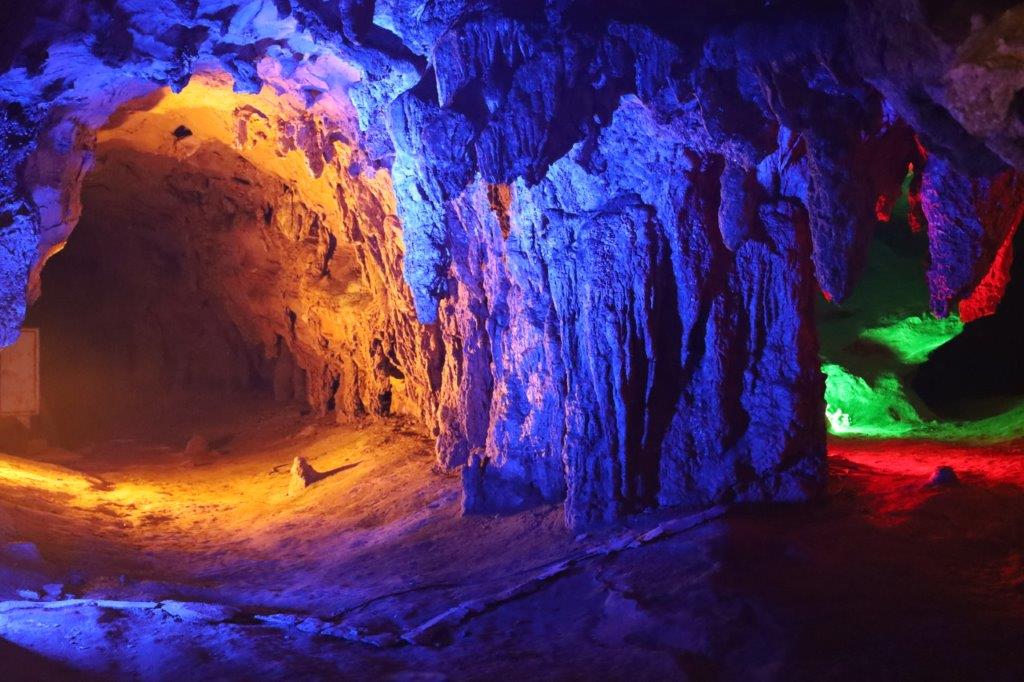 Here, he admired the cave flower, a geological treasure estimated to be 380 million years old, and enjoyed close-up views of formations usually kept behind railings in other caves.
Here, he admired the cave flower, a geological treasure estimated to be 380 million years old, and enjoyed close-up views of formations usually kept behind railings in other caves.
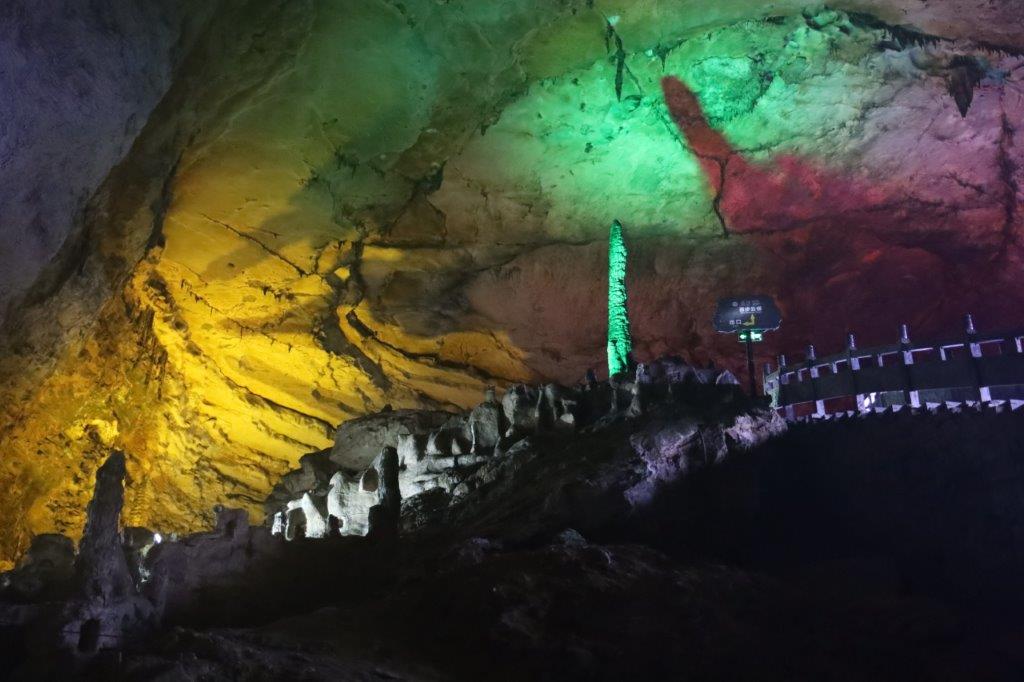 The Maze located at the deepest part of the Yellow Dragon Cave is roughly 1,600 square meters. It represents the best part of the entire Yellow Dragon Cave. For other caves, there are usually protective railings surrounded so that visitors are not able to get close to see things inside. However, after having bought entry tickets to the Maze, visitors are allowed to walk through the cave to see objects closely. The stalactites in the Maze are different in shapes and are very dense. Unlike other caves that are heavily oxidized, the stalactites, curtains, cave flags, cave pearls and so on here still remain their original color, looking extremely beautiful. In the Maze, there is also a cave flower that has been here for 380 million years, and it is the treasure of the Yellow Dragon Cave.
The Maze located at the deepest part of the Yellow Dragon Cave is roughly 1,600 square meters. It represents the best part of the entire Yellow Dragon Cave. For other caves, there are usually protective railings surrounded so that visitors are not able to get close to see things inside. However, after having bought entry tickets to the Maze, visitors are allowed to walk through the cave to see objects closely. The stalactites in the Maze are different in shapes and are very dense. Unlike other caves that are heavily oxidized, the stalactites, curtains, cave flags, cave pearls and so on here still remain their original color, looking extremely beautiful. In the Maze, there is also a cave flower that has been here for 380 million years, and it is the treasure of the Yellow Dragon Cave.
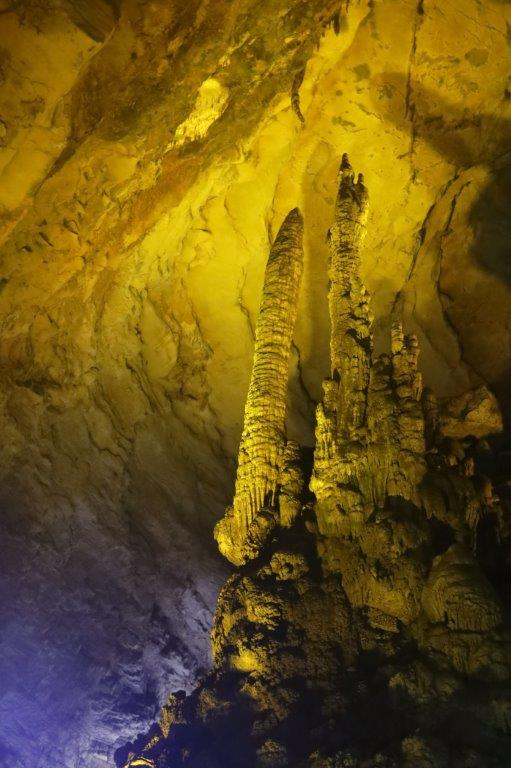 Each section—Dragon Dancehall, the Maze, and more—offered its own surprises, from echoing waterfalls to tight corridors lined with ancient stone columns.
Each section—Dragon Dancehall, the Maze, and more—offered its own surprises, from echoing waterfalls to tight corridors lined with ancient stone columns.
Although the lights are exuberant in western eyes, you get used to them. Let me explain a bit for asians. I Europe we do have caves and we of course use lights in tourist accessable caves, but they are always just white lights.
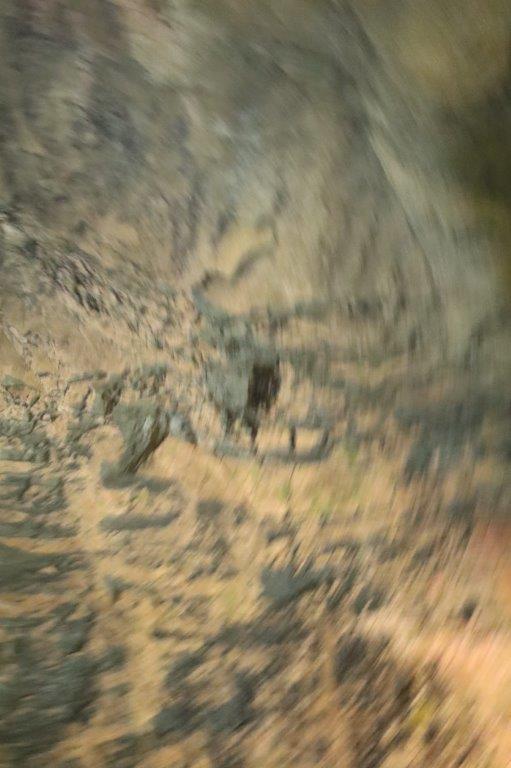 After a long climb of what really seemed at times like an endless staircase, The Wandelgek reached the:
After a long climb of what really seemed at times like an endless staircase, The Wandelgek reached the:
Dragon Palace Cave
This largest cave in Yellow Dragon Cave is over 200,000 years old. It has an average height of 40 meters (130 feet). There are more than 1,700 stalagmites in various poses and stone columns in the Dragon Palace. Among them, 516 stalagmites are high over 1 meter (3.3 feet), and the distribution density of stalagmites is 0.12 per square meter.
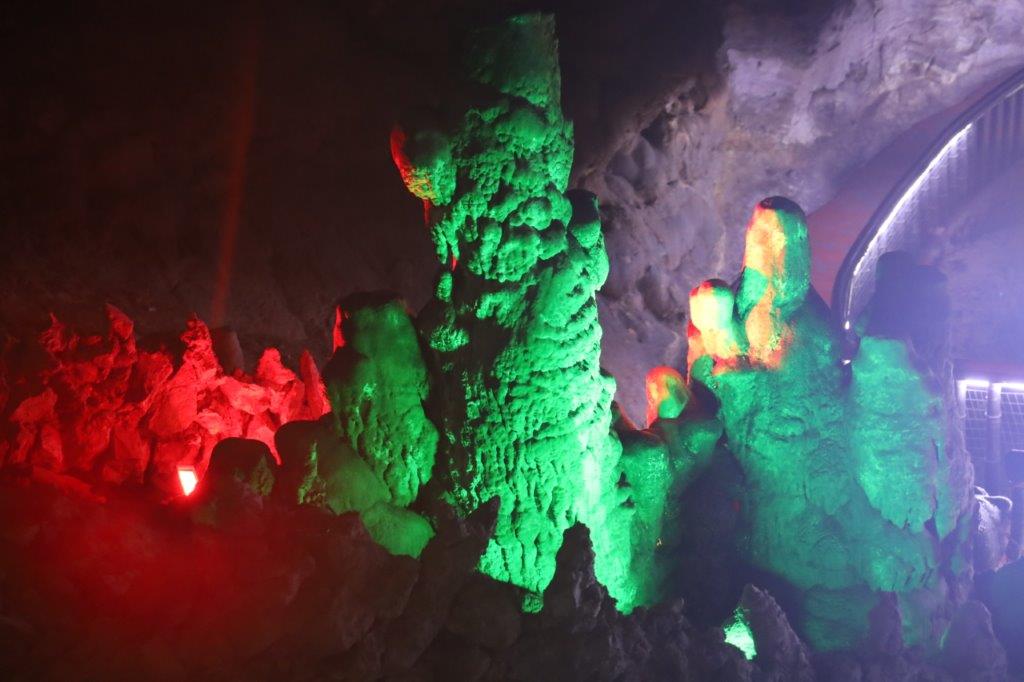 The cave’s colossal chambers and winding passages reveal an astonishing world: stalactites, stalagmites, stone curtains, stone flowers, and even “stone pianos” shimmer under colorful lights, each formation more fantastical than the last.
The cave’s colossal chambers and winding passages reveal an astonishing world: stalactites, stalagmites, stone curtains, stone flowers, and even “stone pianos” shimmer under colorful lights, each formation more fantastical than the last.
Unlike other famous caves in China, such as Guilin’s Reed Flute Cave or the Benxi Water Cave, Yellow Dragon Cave stands out for its immense stalagmite columns and vast halls.
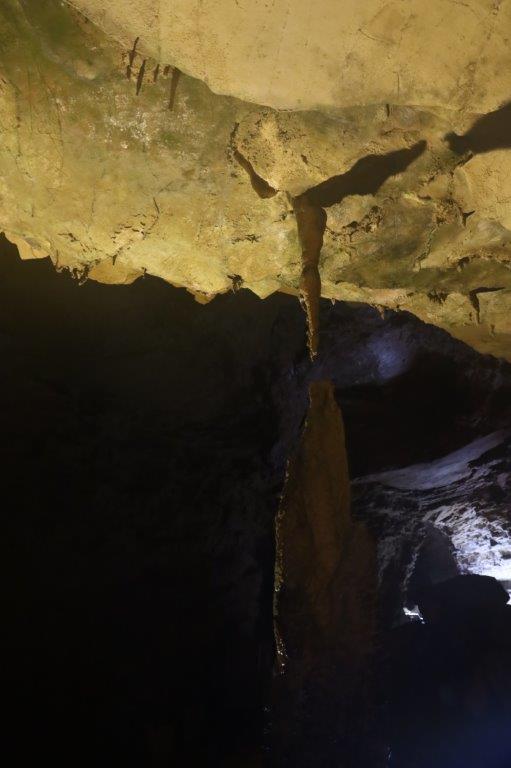 The Dragon Palace Hall, the cave’s grand centerpiece, feels like stepping into a myth—home to the iconic Sea-Calming Needle, a slender 19.2-meter stalagmite that seems to defy gravity and legend alike. Here, I wandered among more than 1,700 stalagmites, some towering over a meter high, and marveled at the Dragon King’s Throne and the Millennium Cedar, each with its own story.
The Dragon Palace Hall, the cave’s grand centerpiece, feels like stepping into a myth—home to the iconic Sea-Calming Needle, a slender 19.2-meter stalagmite that seems to defy gravity and legend alike. Here, I wandered among more than 1,700 stalagmites, some towering over a meter high, and marveled at the Dragon King’s Throne and the Millennium Cedar, each with its own story.
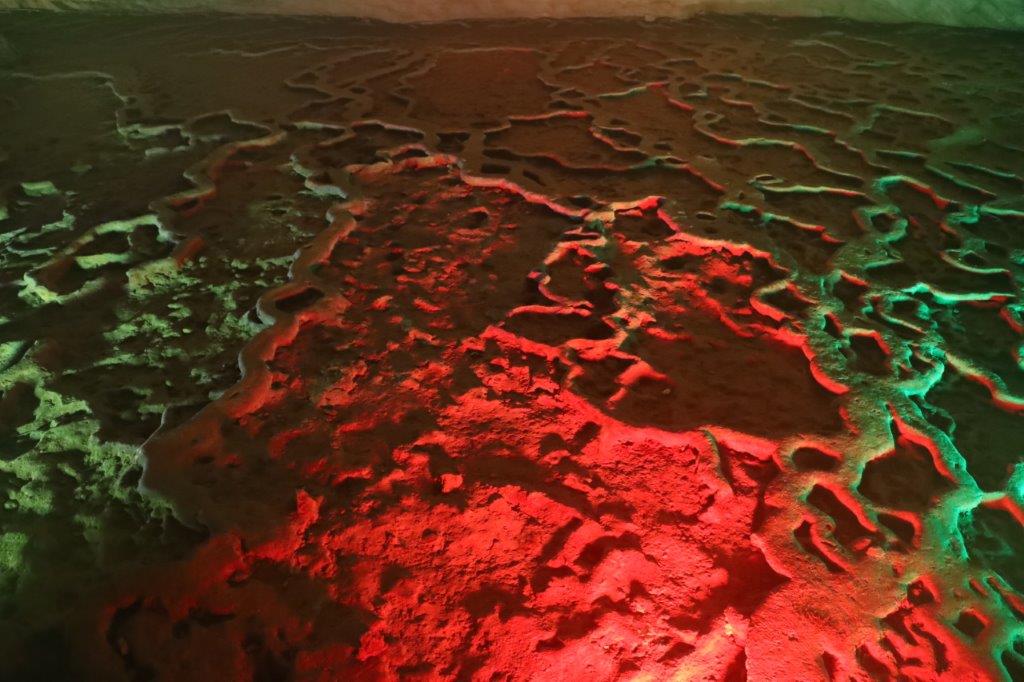 Every corner of Yellow Dragon Cave is a testament to nature’s artistry and the legends that inspired its name. For any traveler, and especially for The Wandelgek, this was a subterranean wonderland not to be missed.
Every corner of Yellow Dragon Cave is a testament to nature’s artistry and the legends that inspired its name. For any traveler, and especially for The Wandelgek, this was a subterranean wonderland not to be missed.
 The hall of the Dragon Palace located on the top layer (the fourth layer) of the cave.
The hall of the Dragon Palace located on the top layer (the fourth layer) of the cave.
As the oldest and the largest hall of the Yellow Dragon Cave, the Dragon Palace is the place where the stalagmites grow the best.
The cave hall was formed 200,000 years ago with an area of 14,000 square meters and an average height of 40 meters.
There are in total 1,705 stalagmites inside and the density is 0.12 per square meter.
Among these, there are 516 stalagmites that are higher than 1 meter and there was:
The Dragon King Throne
It is the thickest stalagmite in the Cave, whose hole interior can accommodate 15 adult people …
It really did look a bit like the chair of the Troll King from the dutch amusement park and fairytale forest: The Efteling.
To me it also looked a bit like a hollow tooth …
… a dentist would have quite a job to fill this one though … 😀
 The Sea Suppressing Needle, Throne of Dragon King as well as the Cedar of Ten Thousand Years are the three most interesting places inside the Hall of the Dragon Palace.
The Sea Suppressing Needle, Throne of Dragon King as well as the Cedar of Ten Thousand Years are the three most interesting places inside the Hall of the Dragon Palace.
Looking at these photo’s you might have noticed the bright and many colored lights everywhere in this cave, which is a quite common feature in South east asian and Chinese caves.
I had seen it before when visiting a cave in the Halong Bay area of Vietnam in 2008:
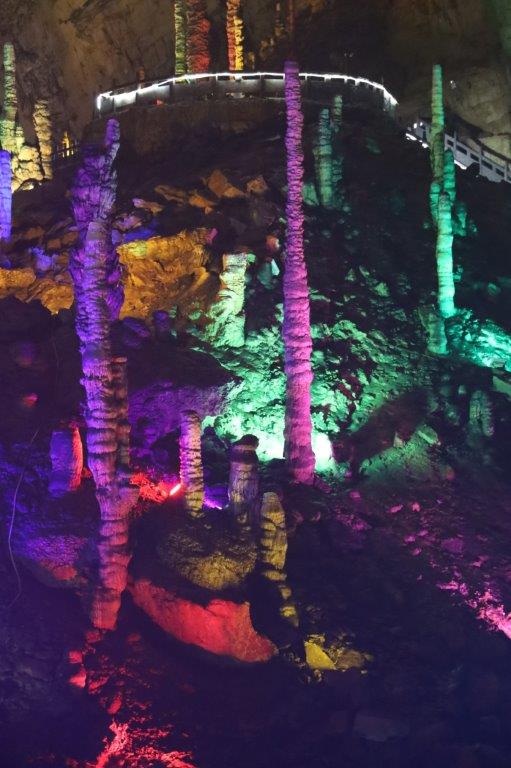 The Sea Suppressing Needle
The Sea Suppressing Needle
As the tallest stalagmite of the Yellow Dragon Cave, the Sea Suppressing Needle is 19.2 meters tall growing on a collapsed slope. The stalagmite column is pretty slim in the middle with the most slim part has only a diameter of 10 cm.
For this reason, the Sea Suppressing Needle looks fragile. You may feel as if it is breaking in the middle at the first sight. However, it is actually at puberty stage and is still growing. Scientists estimated that it took nearly 200,000 years to reach this height today. Scientists also predicated that it would take another overwhelming 60,000 years for it to grow another 6 meters to reach the ceiling based on the current growth rate. The Sea Suppressing Needle is an iconic spot to the Yellow Dragon Cave. To prove its value and to raise tourists’ awareness to protect it, the management team of Yellow Dragon Cave Scenic Spot has bought it an insurance of up to 100 million Chinese Yuan dating back to 1998.
It looks very fragile…
19.2 meters high is really impressive…
This cave was soooo large that the warnings up front by the guides, were really making sense. Do not fall behind and loose contact, because you can easily get lost here. That might be even more true after the lights are dimmed or shut down.
… and there were many more strange stalagmites to admire ….
The names of some of the stalagmites are quite inventive. Beneath I see indeed an Eagle sitting on a flat topped rock, next to a large stalagmite.
What name would this rock have?
It’s a bit like a monster who opened his jaws …
Magic Cudgel Stalagmite
The third wonder is “Magic Cudgel”, or “Ding Hai Shen Zhen” in Chinese, which is a landmark in Yellow Dragon Cave.
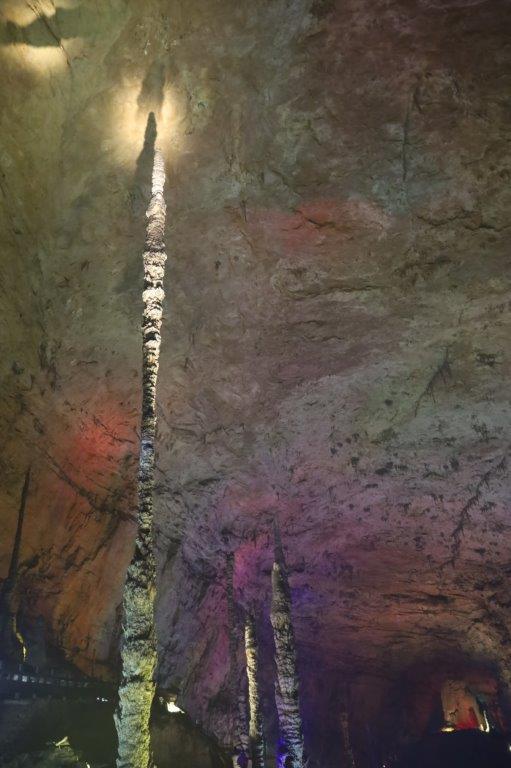 It is a stalagmite with a height of 19.2 meters (63 feet), the highest stalagmite in the Cave.
It is a stalagmite with a height of 19.2 meters (63 feet), the highest stalagmite in the Cave.
It is estimated that it takes at least 200,000 years for this stalagmite to grow to such a height.
The shape is very strange: thick at two ends and thin in the middle, and the thinnest part is only 0.1 meter (0.11 yard) in diameter.
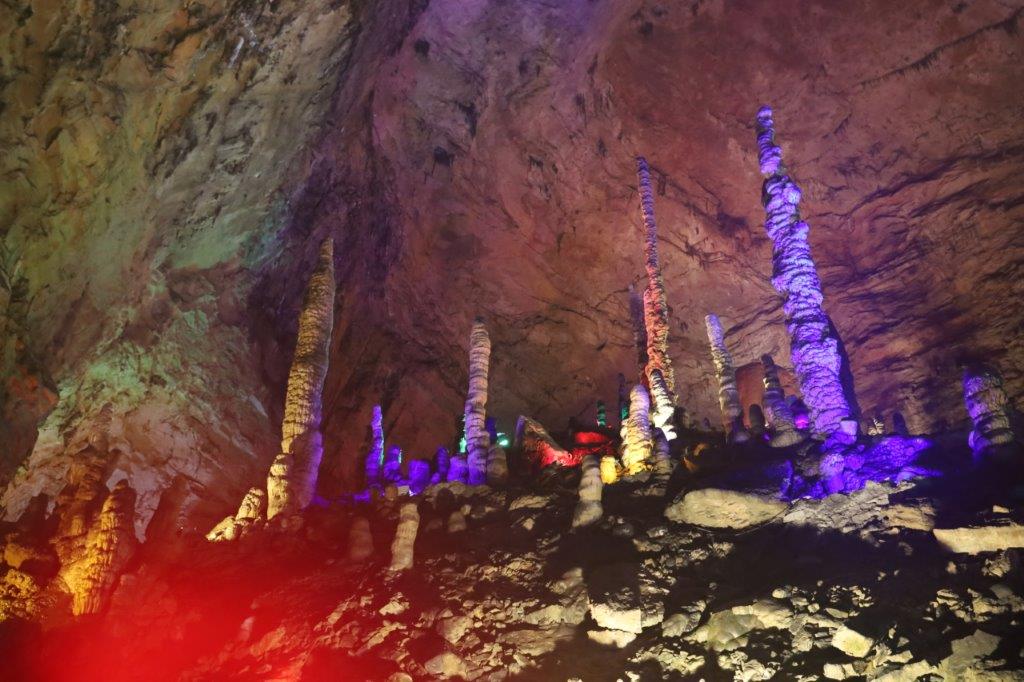 The insured amount of this stalagmite is about CNY 100,000,000.
The insured amount of this stalagmite is about CNY 100,000,000.
Some parts of the caves are like spectacular stalactite waterfalls…
I loved this area a lot, with the chalk stones dripping down very slowly…
This one almost looked like an egg and a sausage with green veggies sprinkled on top …
This was not as strange as it might seem to you, because in these caves tests were done with plants growing inside caves …
Light sources of pure white light were helping the photosynthesis of the tiny plants …
One of the caves was so large and specificly shaped that it was ideal for creating all sorts of sounds whenever the stalagmites were hit with e.g. are rock.
On top 9f that the hall also resonated to human voices and worked like a large echo chamber …
Naturally The Wandelgek had to try this …
Going down The Wandelgek now reached the level of the cave’s entrance, but before leaving he descended further and was astonished by the mesmerizing bright colored lights ….
Another thing these caves were used for was as a wine cellar and there were metal cannisters …
As well as clay barrels in this environment which was large, cool and dark and thus ideal as a wine cellar …
Completing the Walk
After marveling at the wonders of the Dragon Palace, The Maze and the underground river, The Wandelgek concluded his journey by walking out of the cave, ascending through chambers filled with breathtaking karst formations, pools, and waterfalls. The entire tour, took about two hours and offered a unique perspective on one of the world’s most spectacular cave systems. The entire tour to the Yellow Dragon Cave takes roughly 2 hours.
Foodie heaven
After my visit to the Huanglong Cave, it was time for some food and near the exit was a food stall gallery where I could try and taste some delicious street food. The choice in these food galleries is always immense …
This e.g. was a spicy kind of sausage …
… and this was blueberry icecream ….
Loved it!!!
This large bug was hanging onto the window of my bus as it was descending
Then The Wandelgek returned to his hotel.
